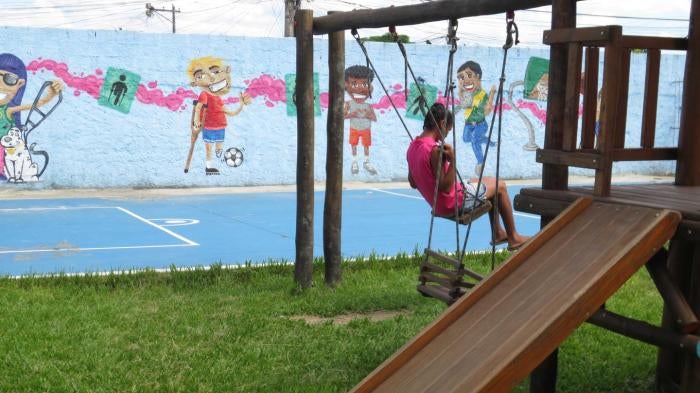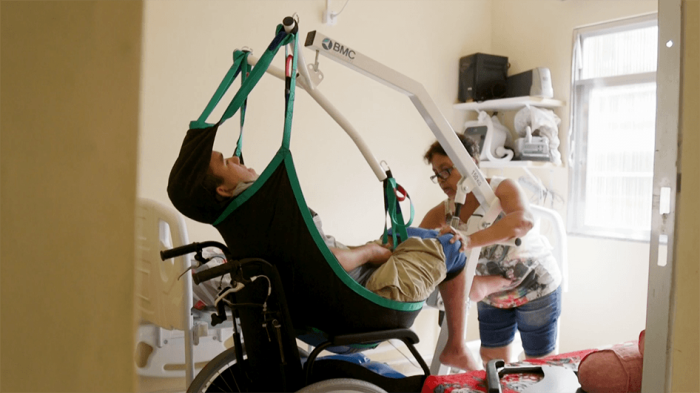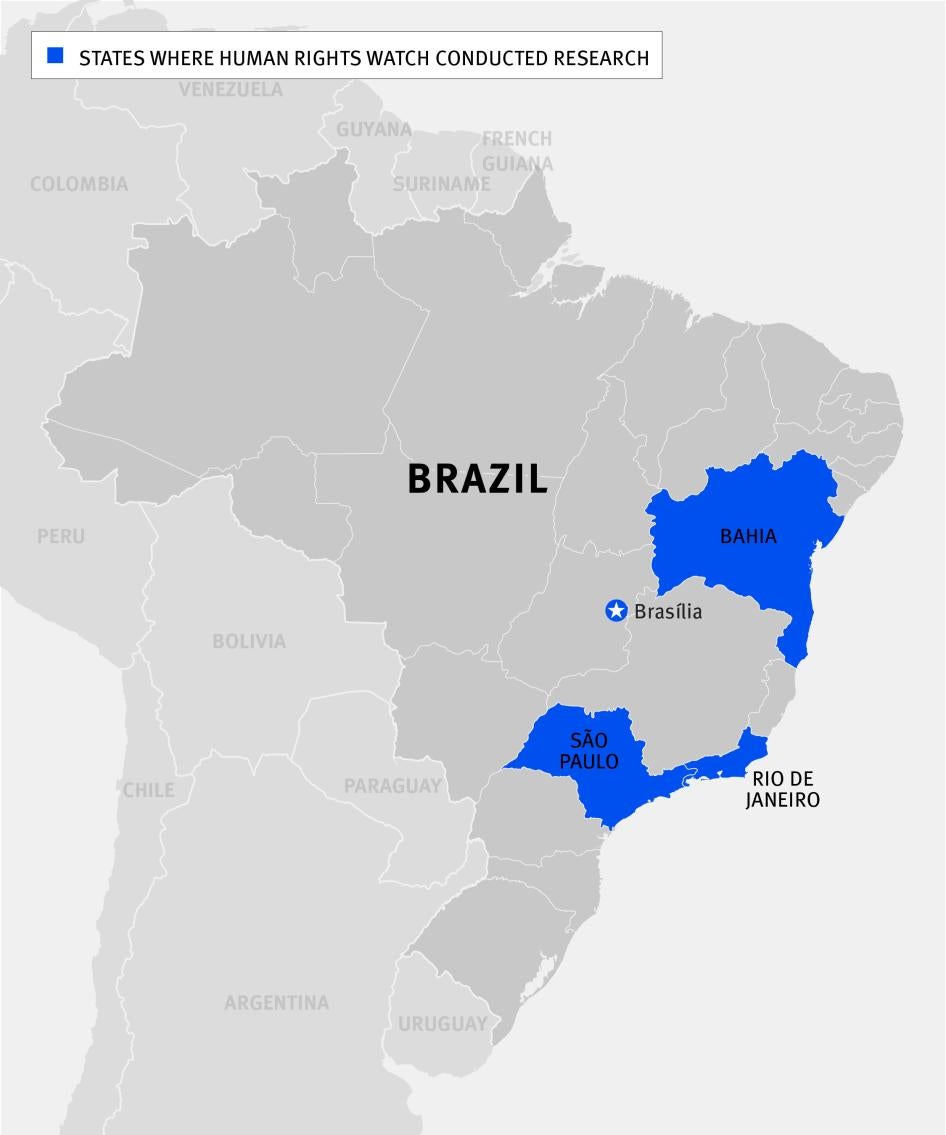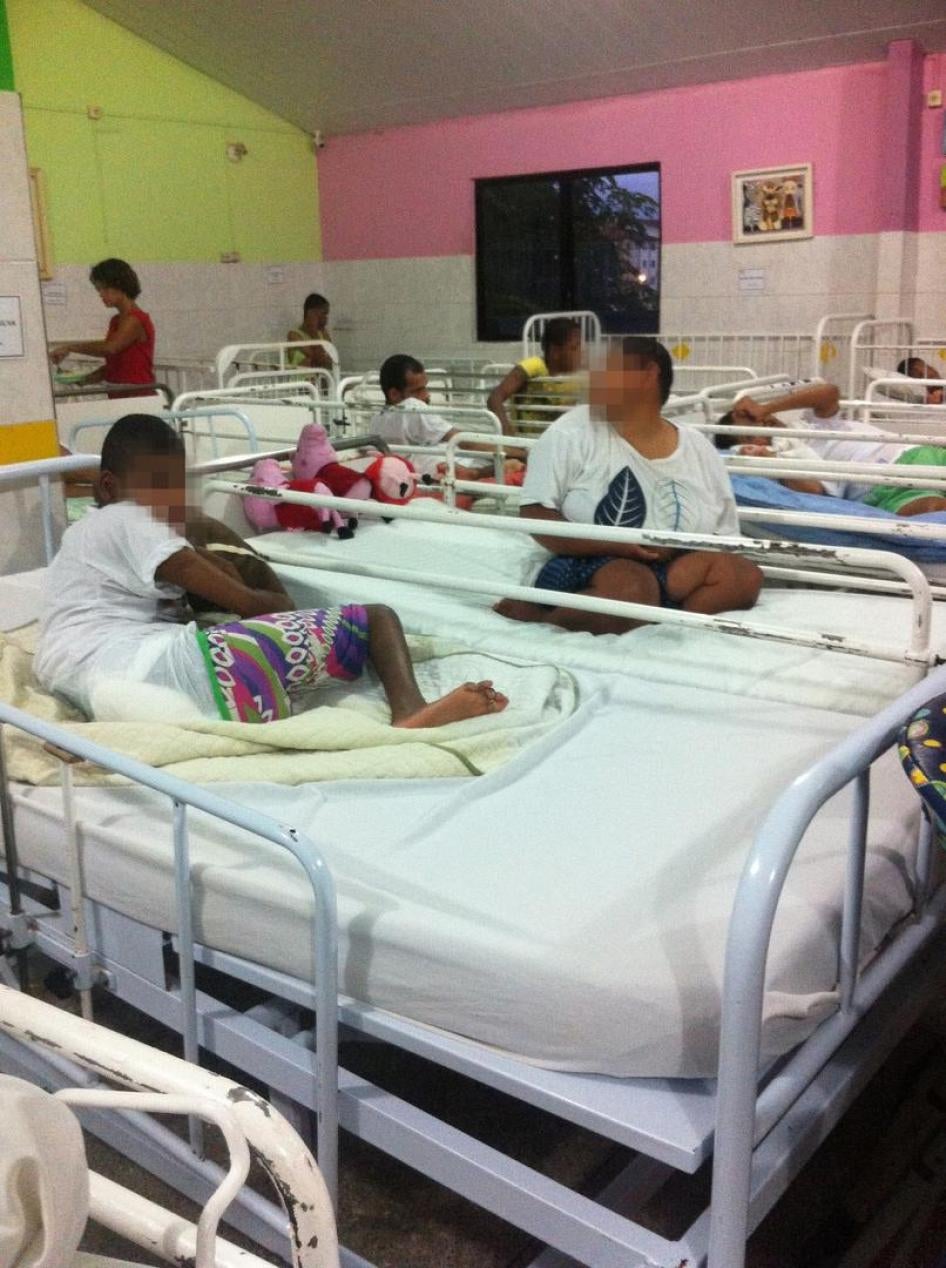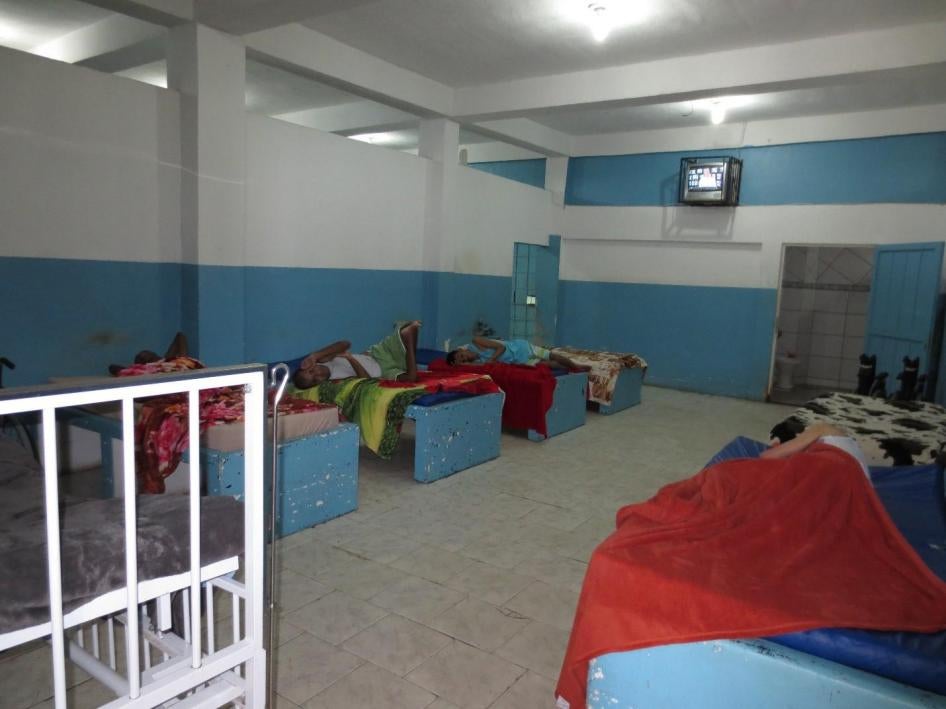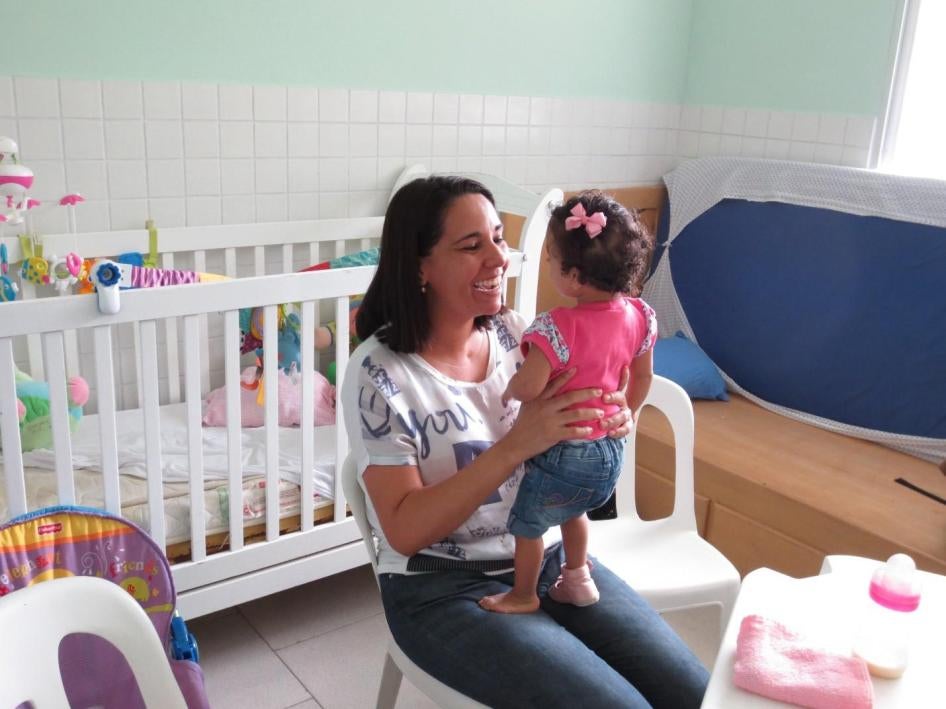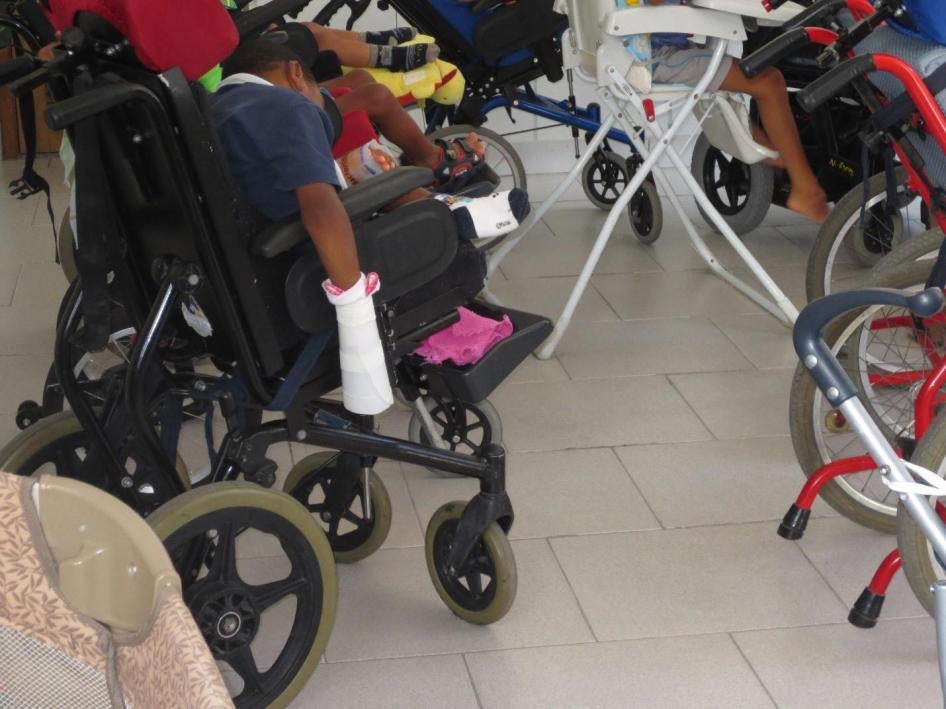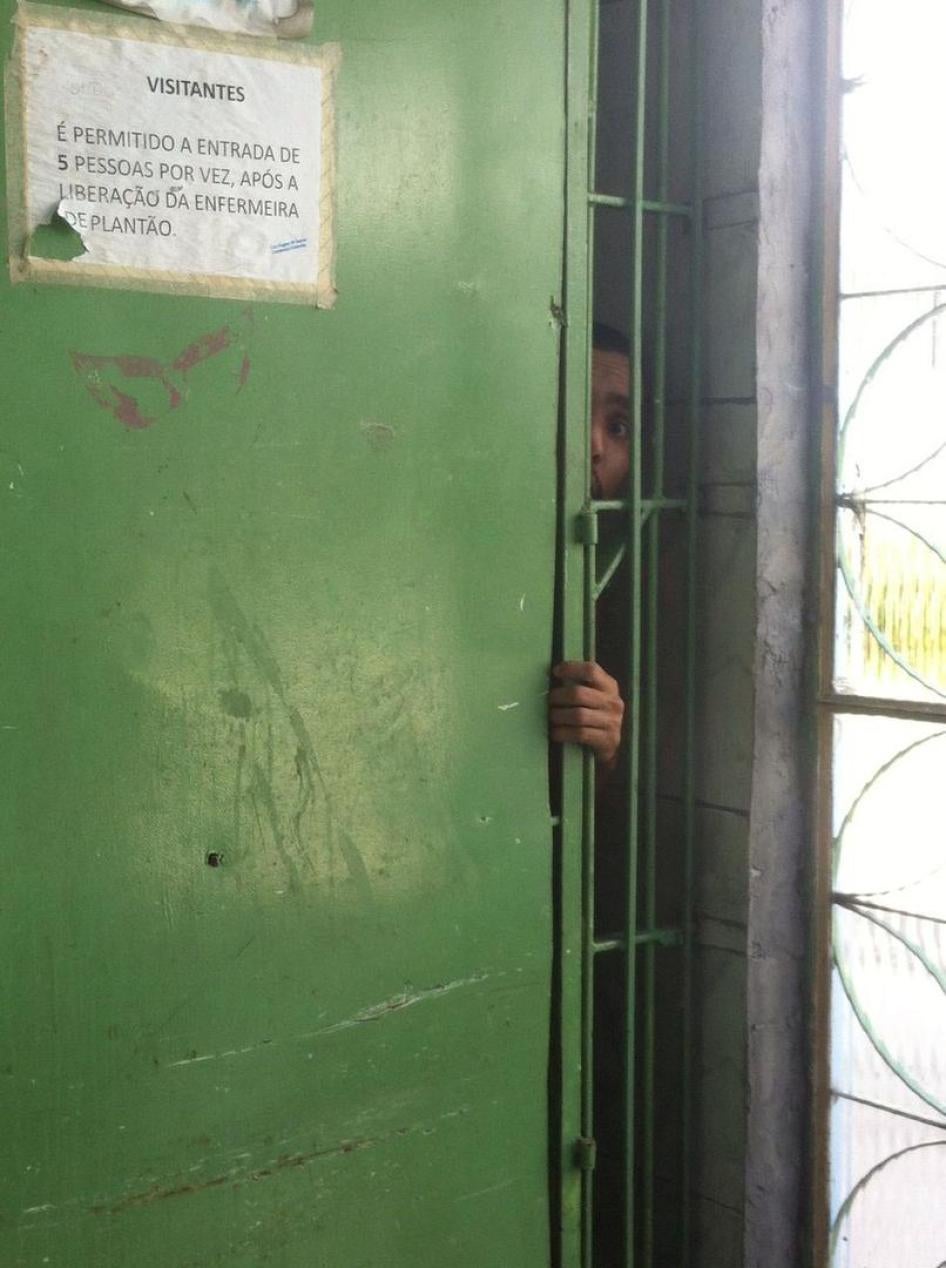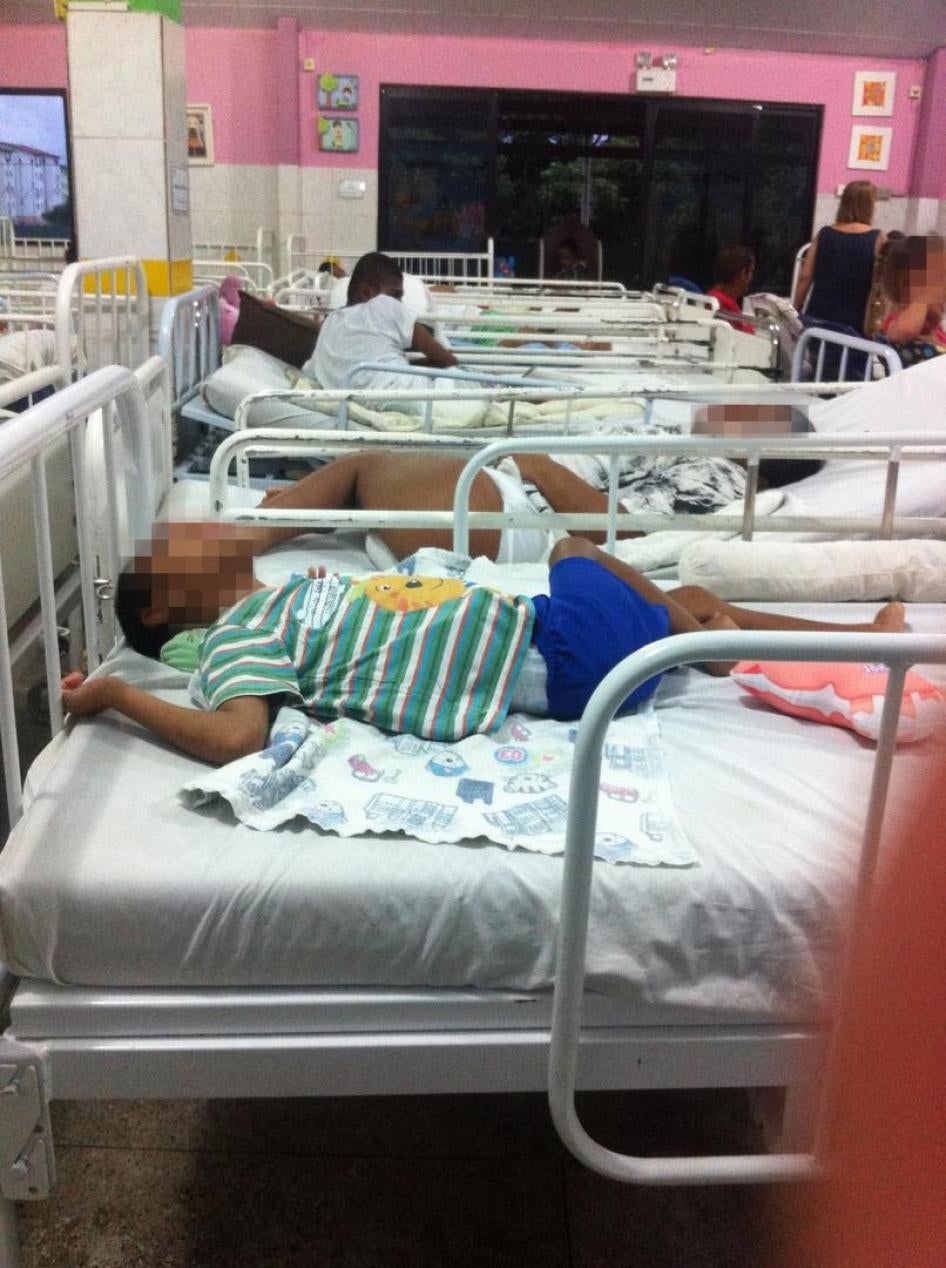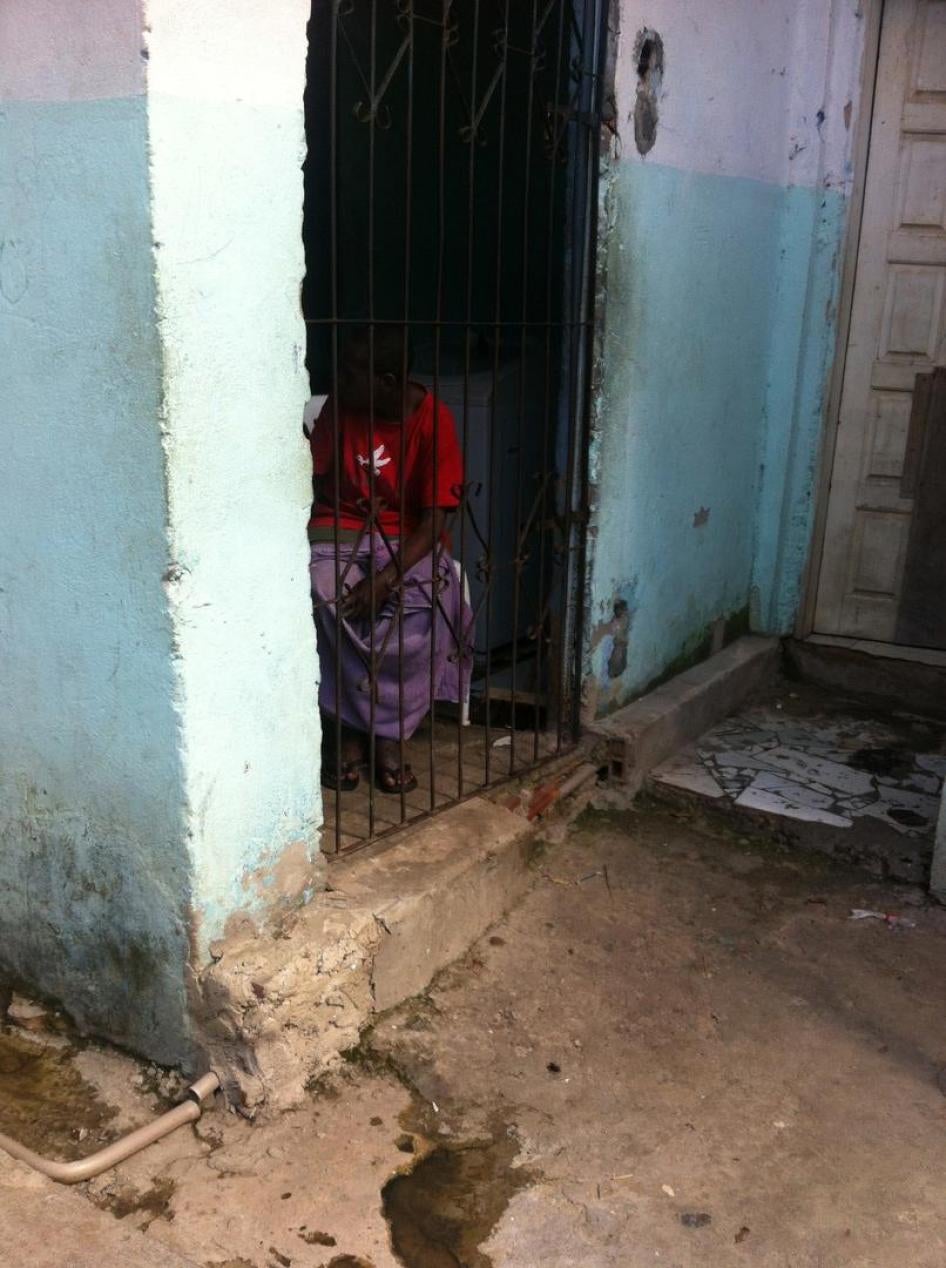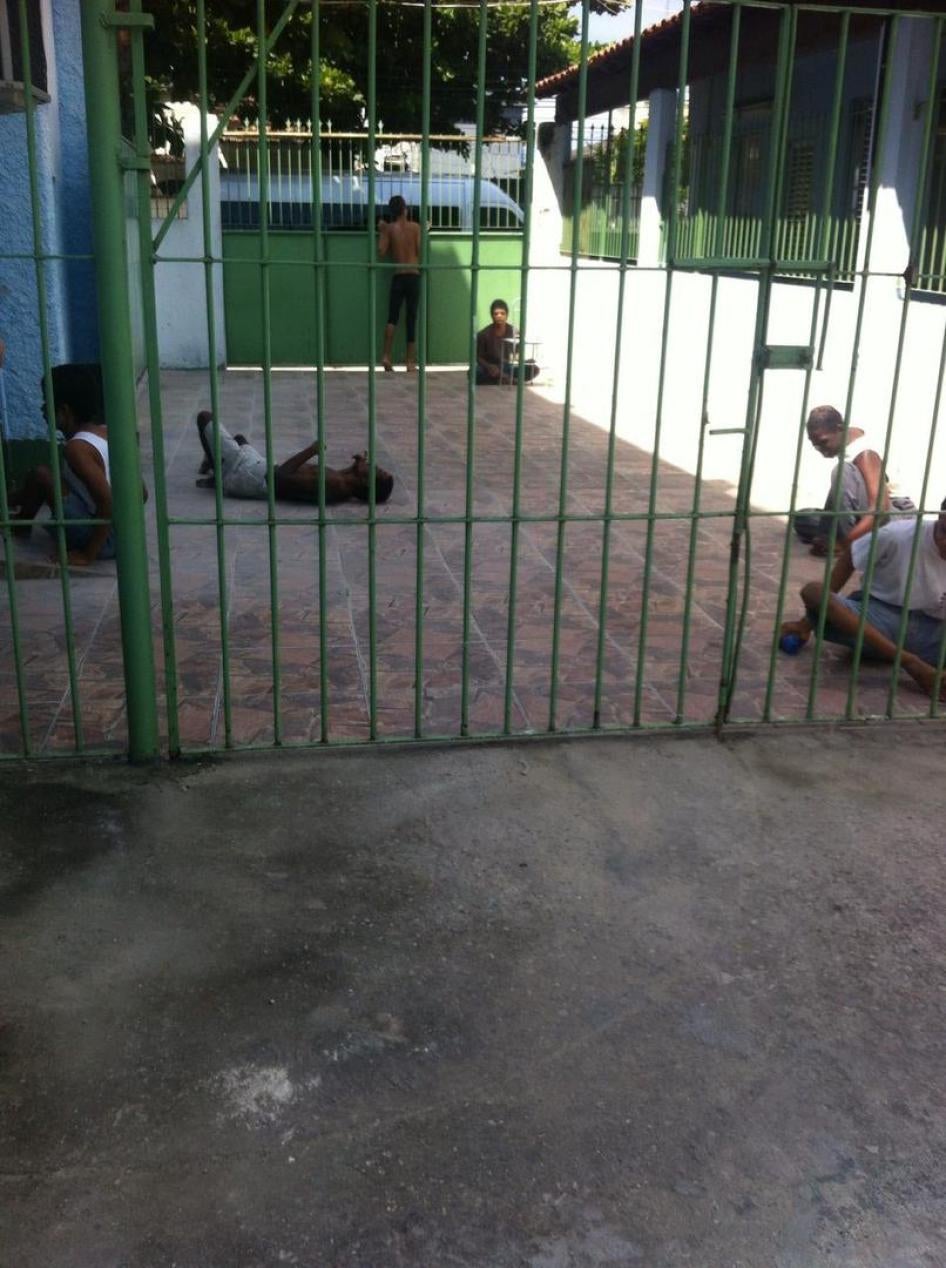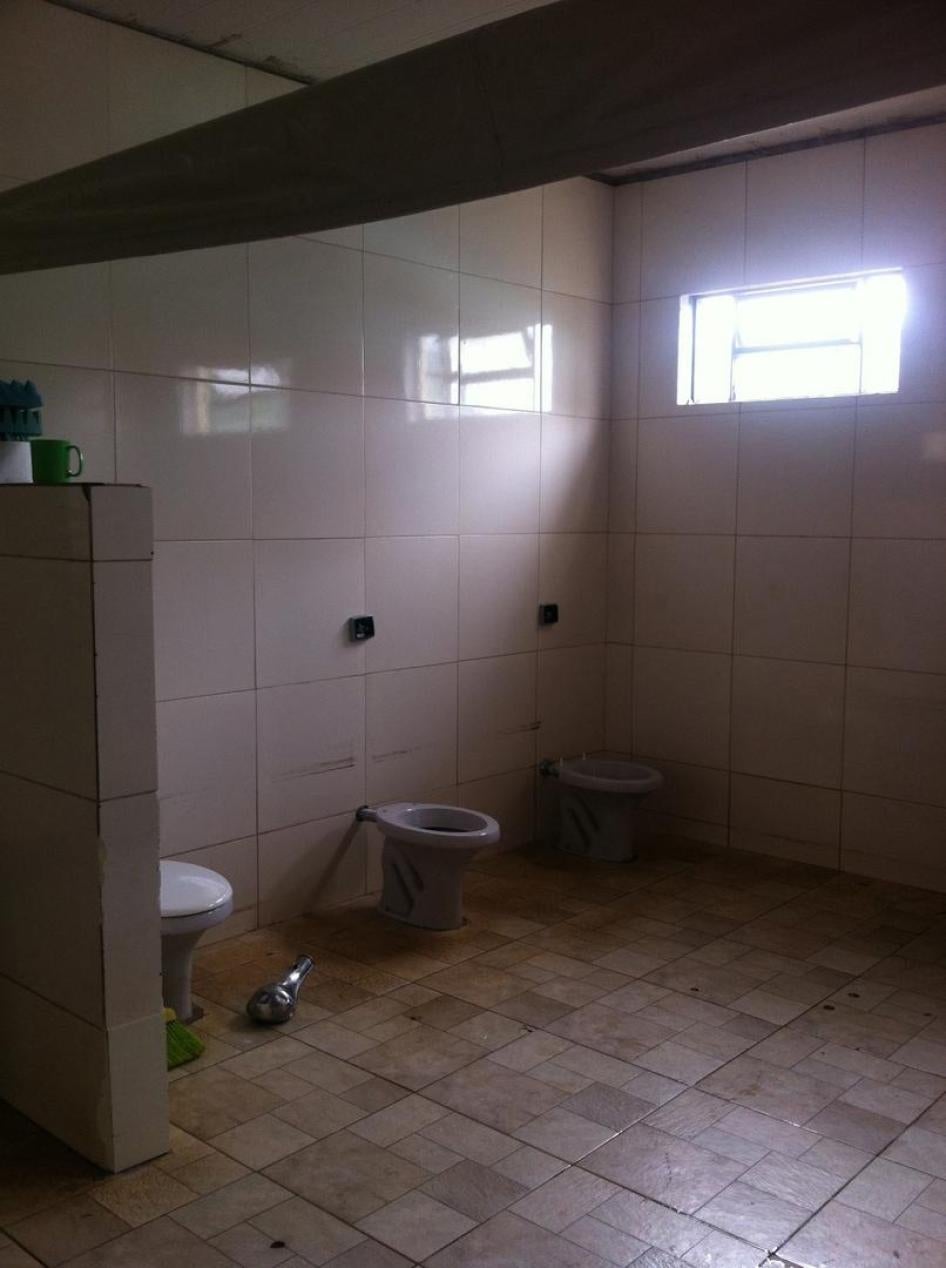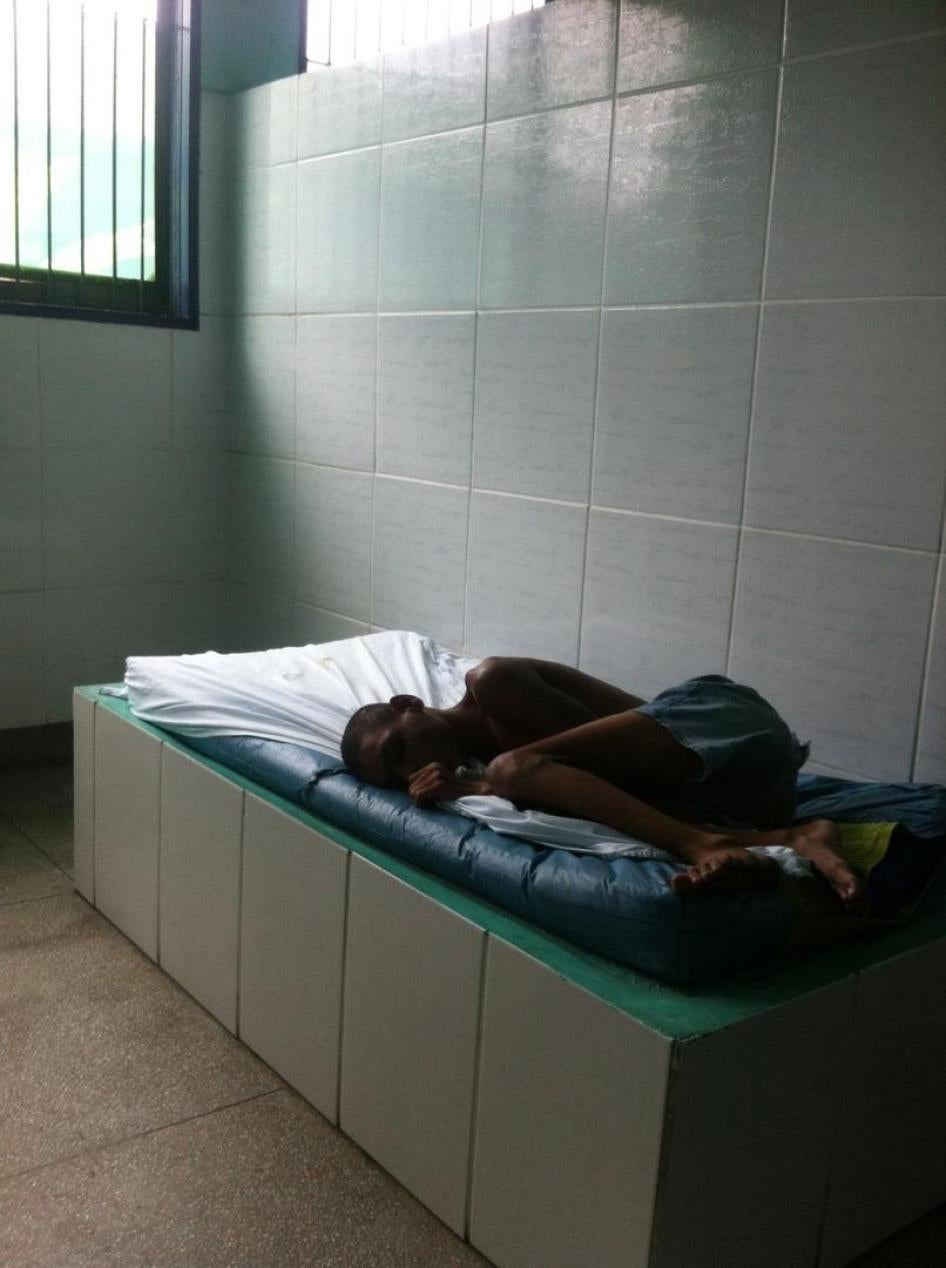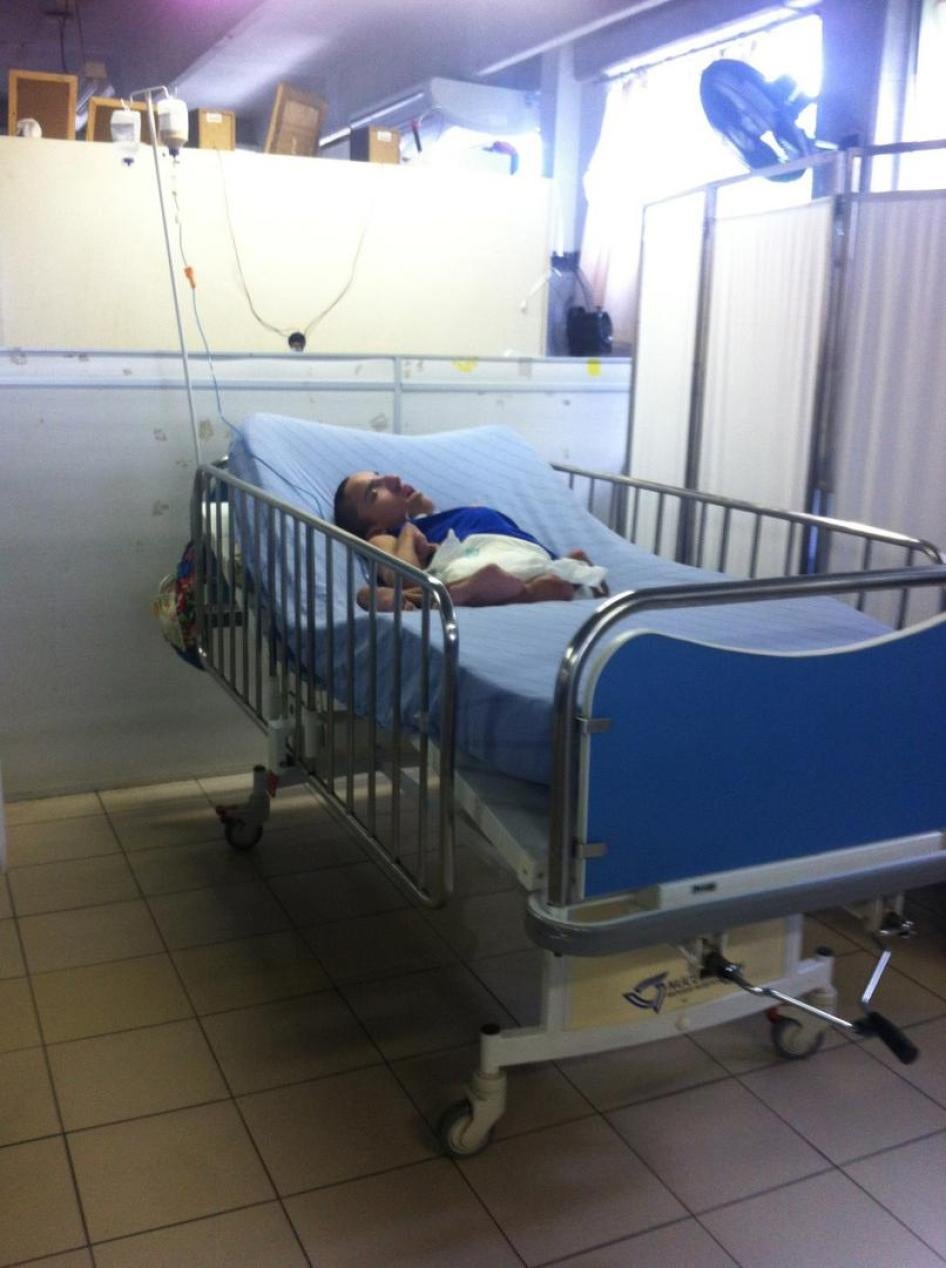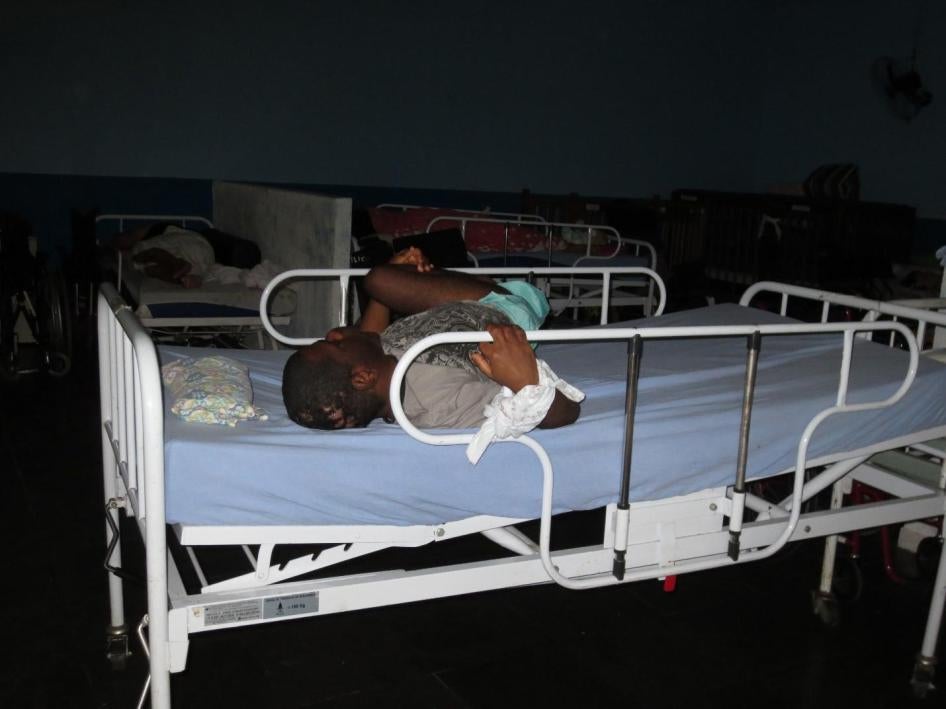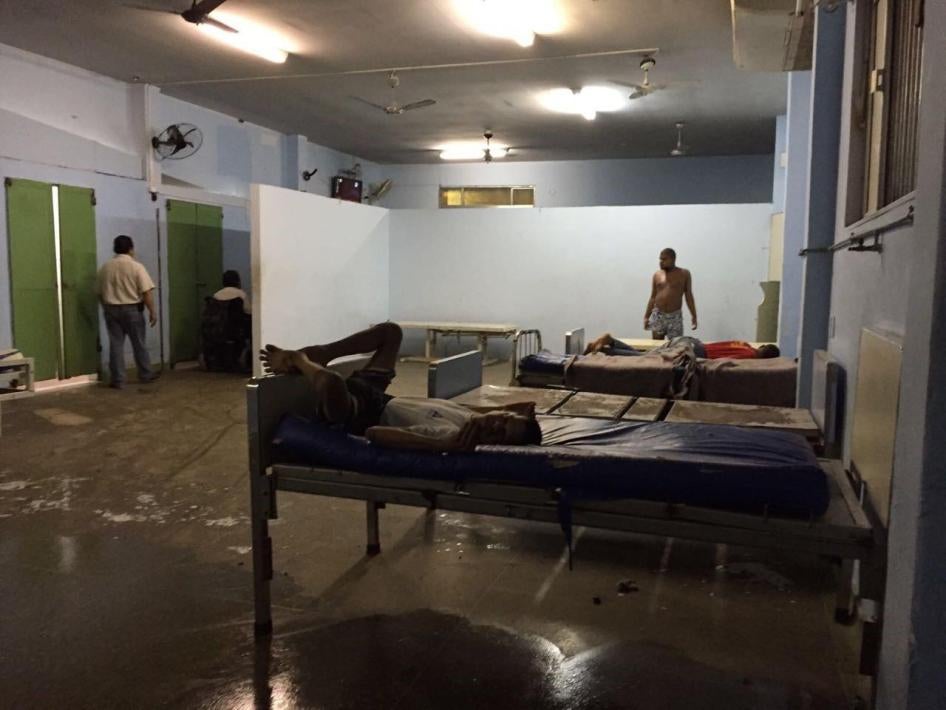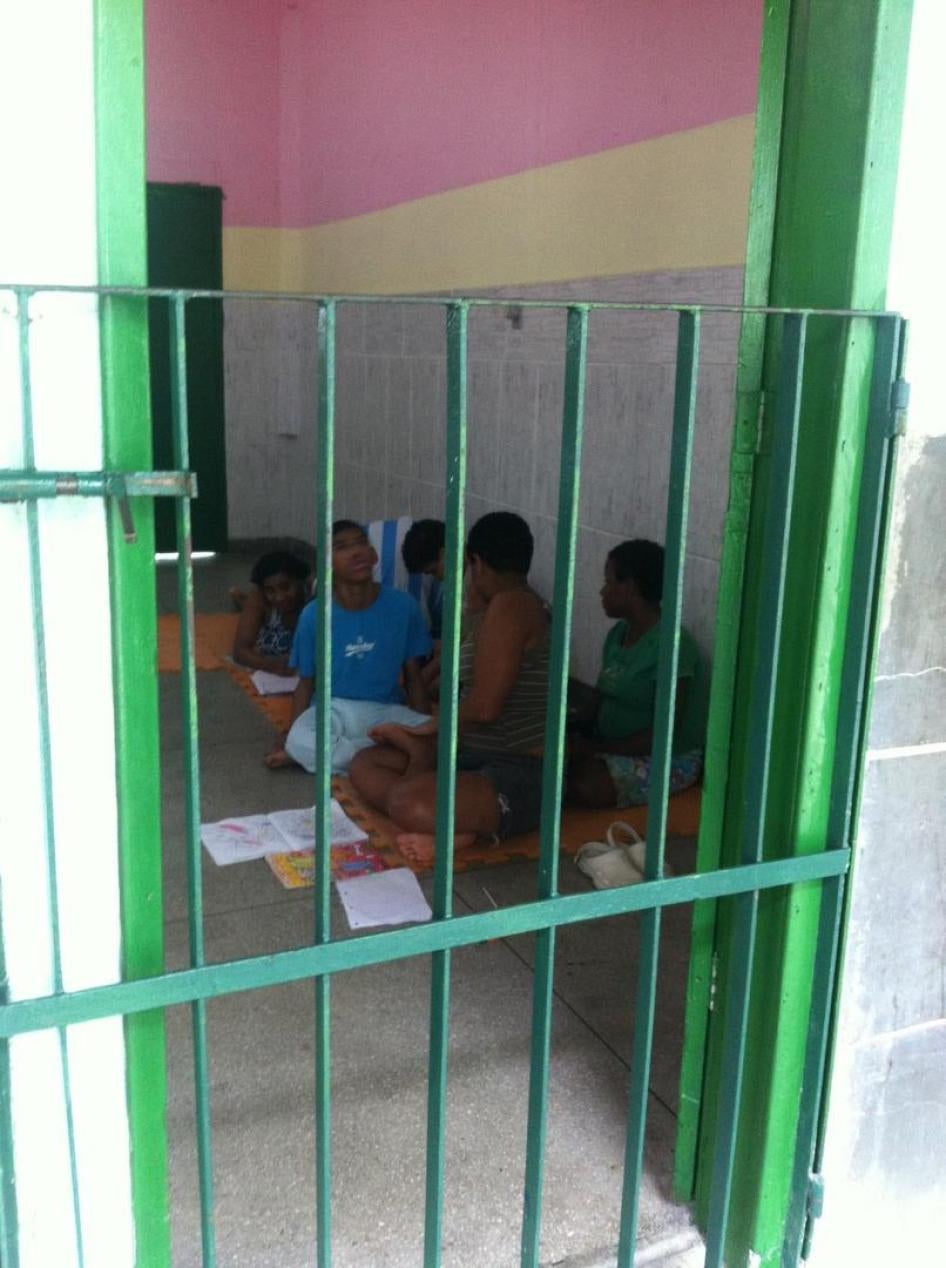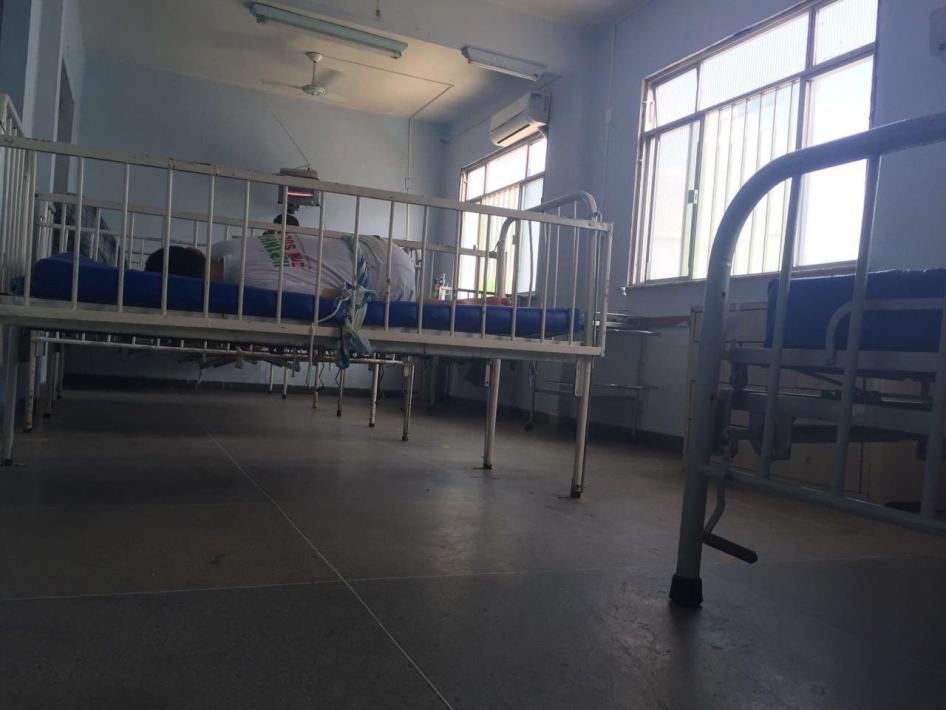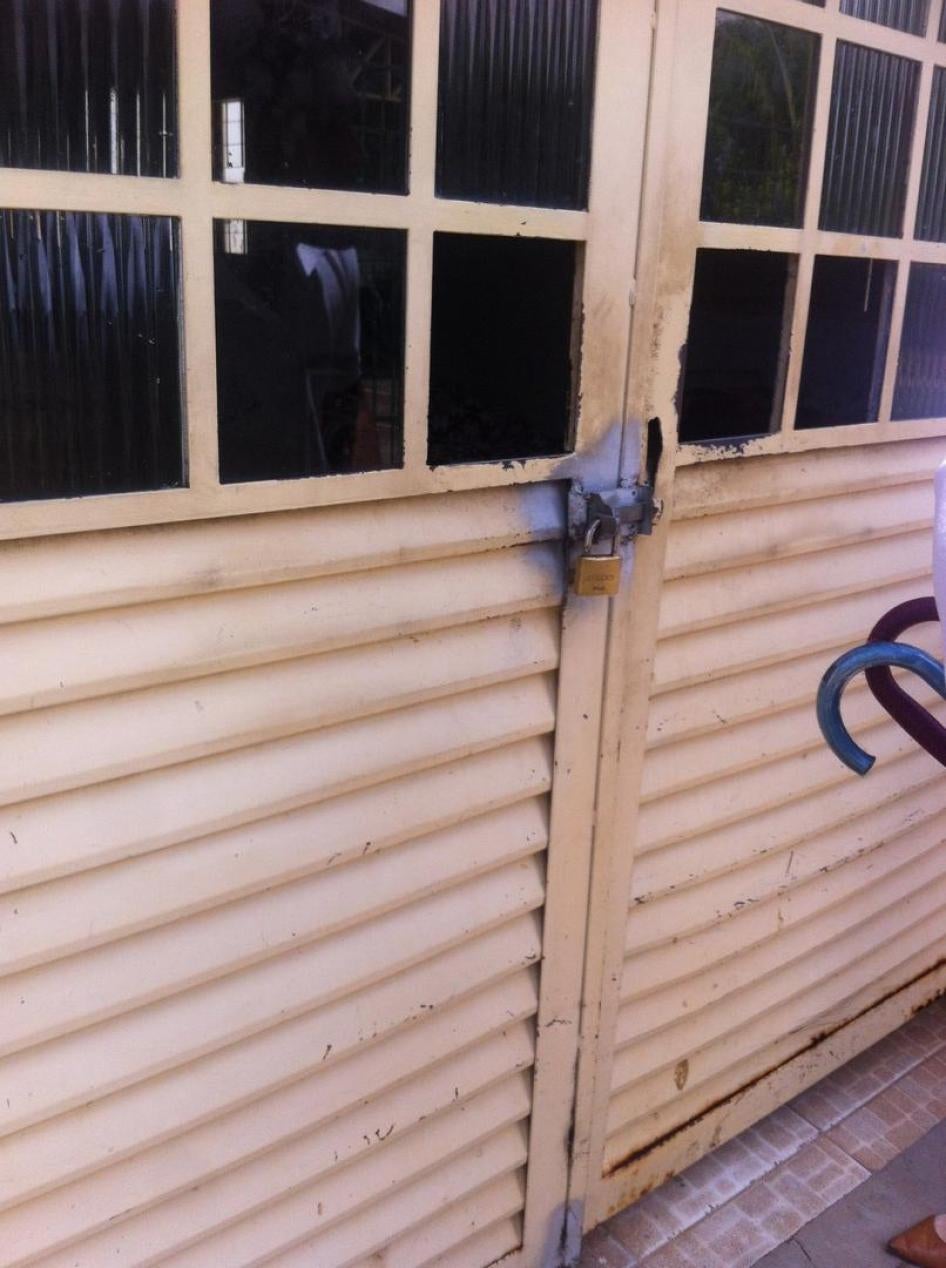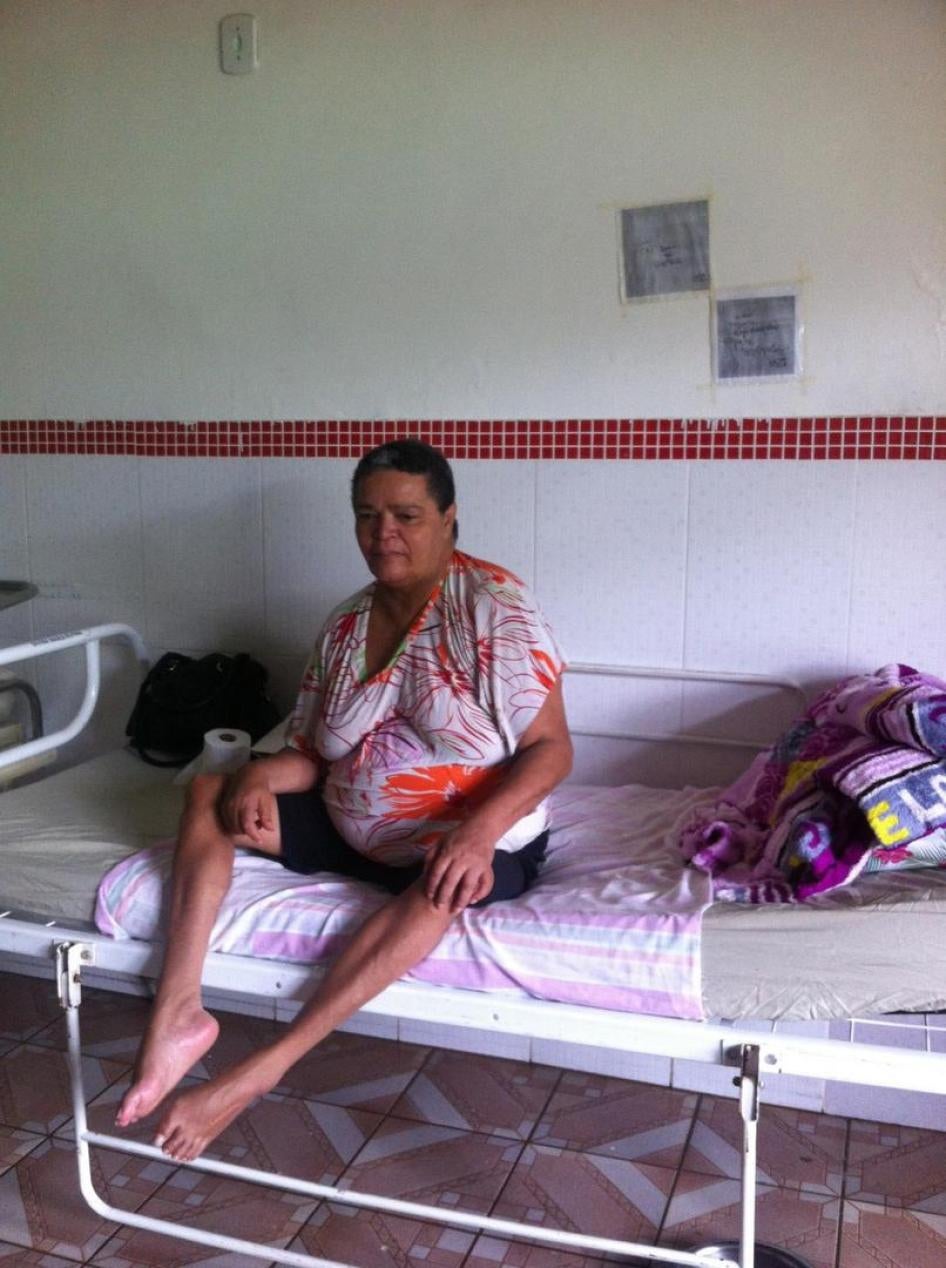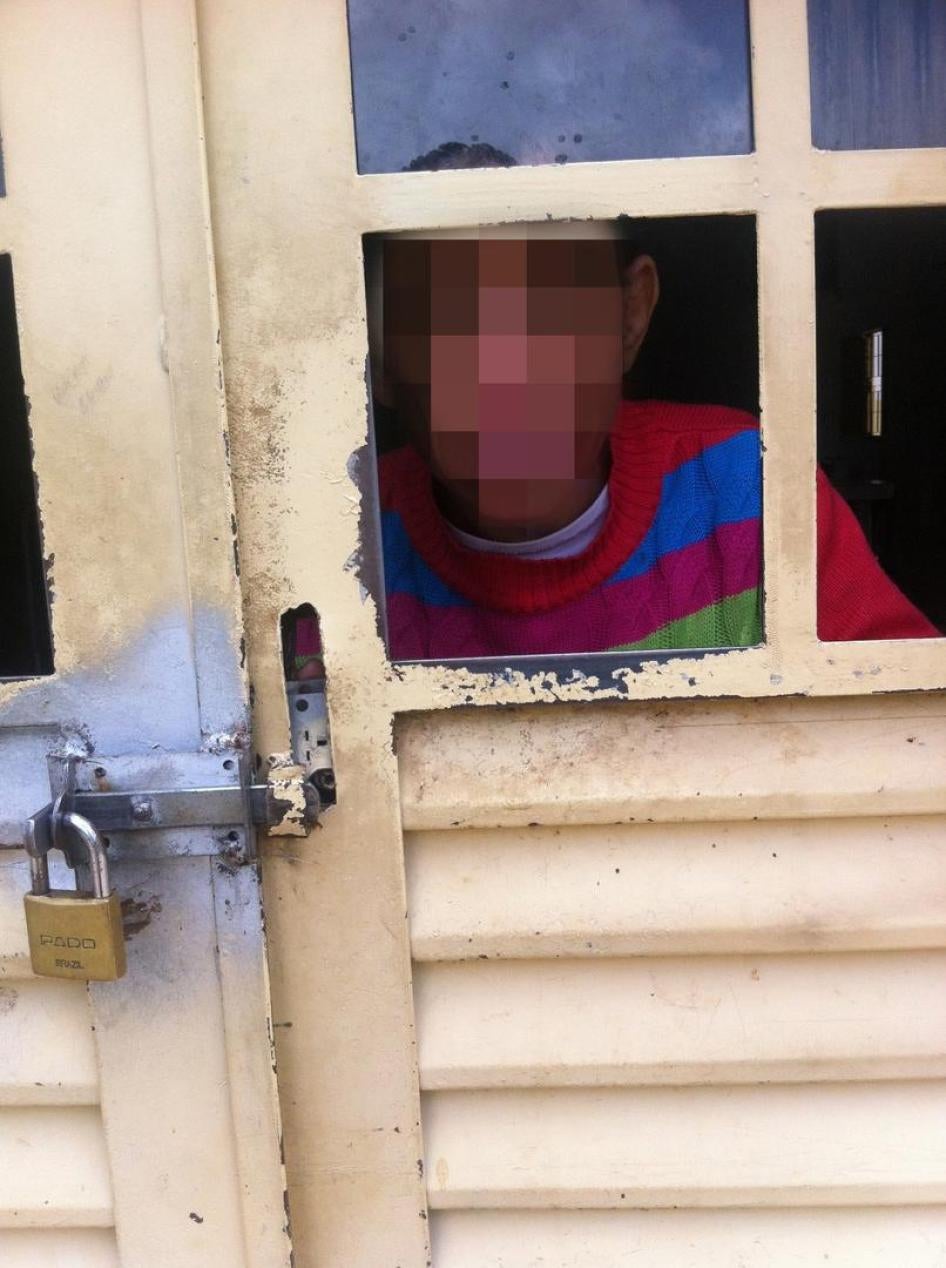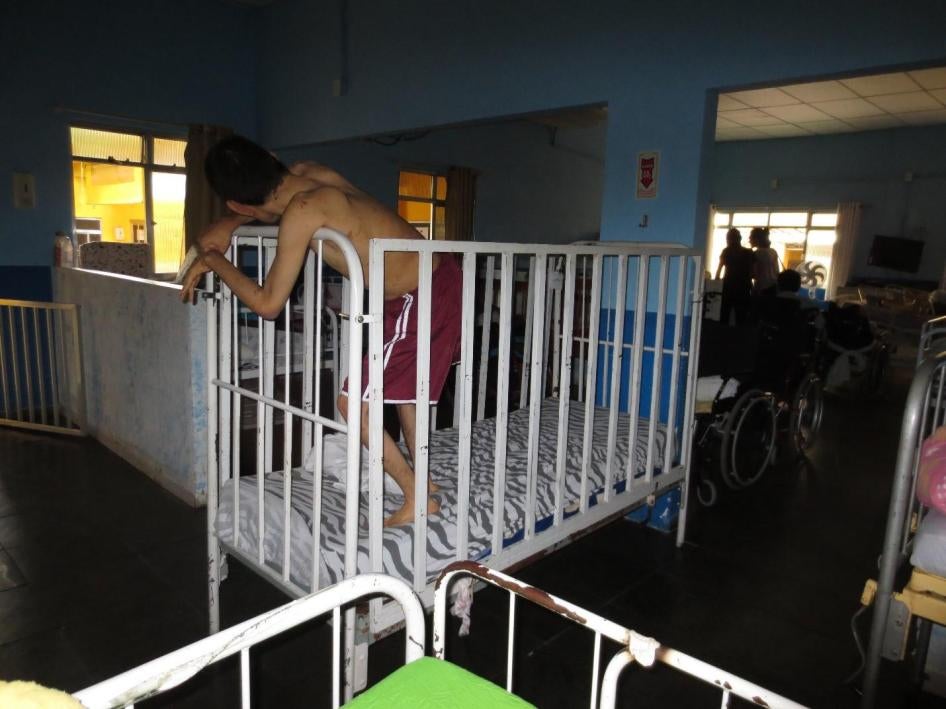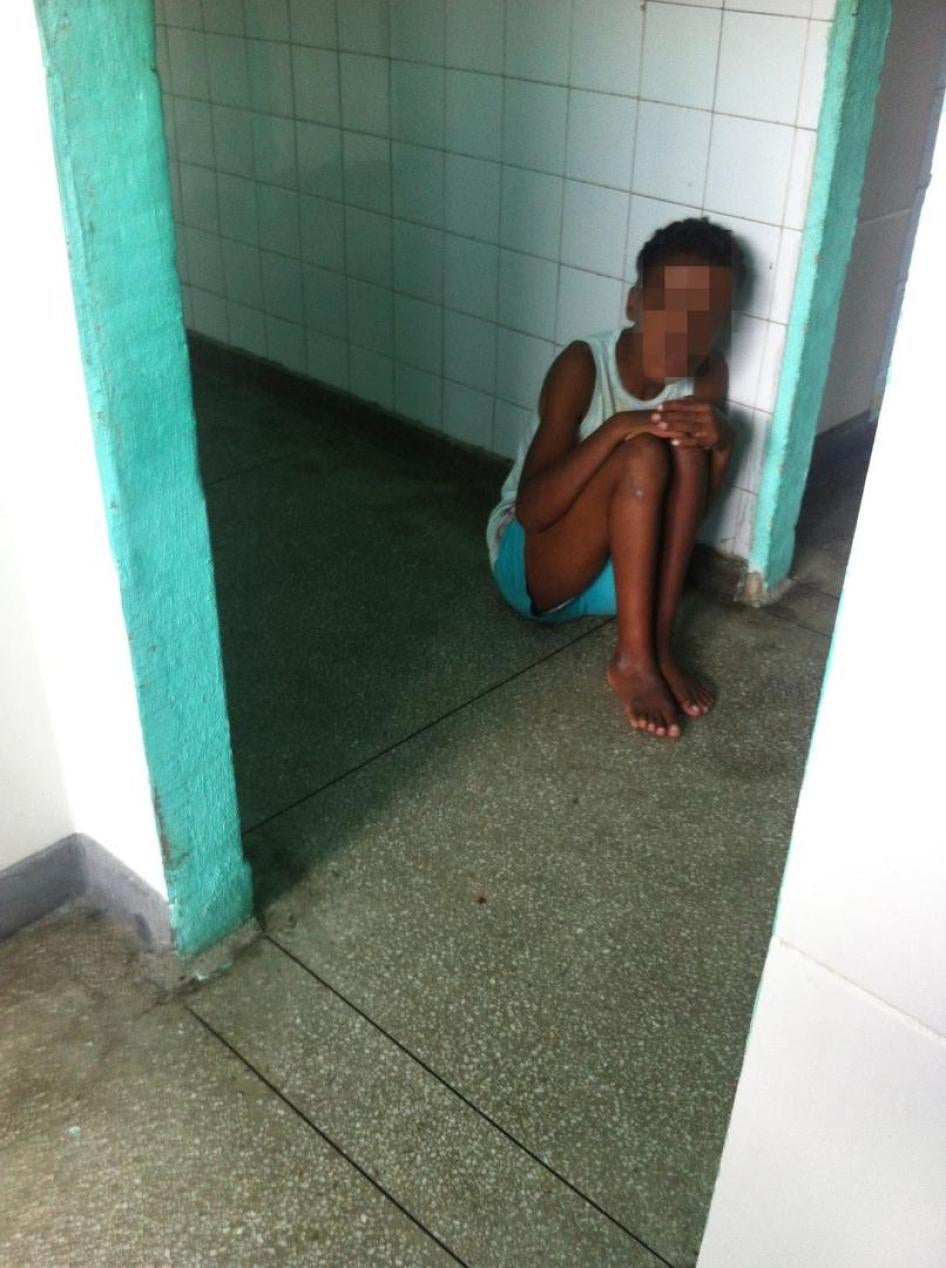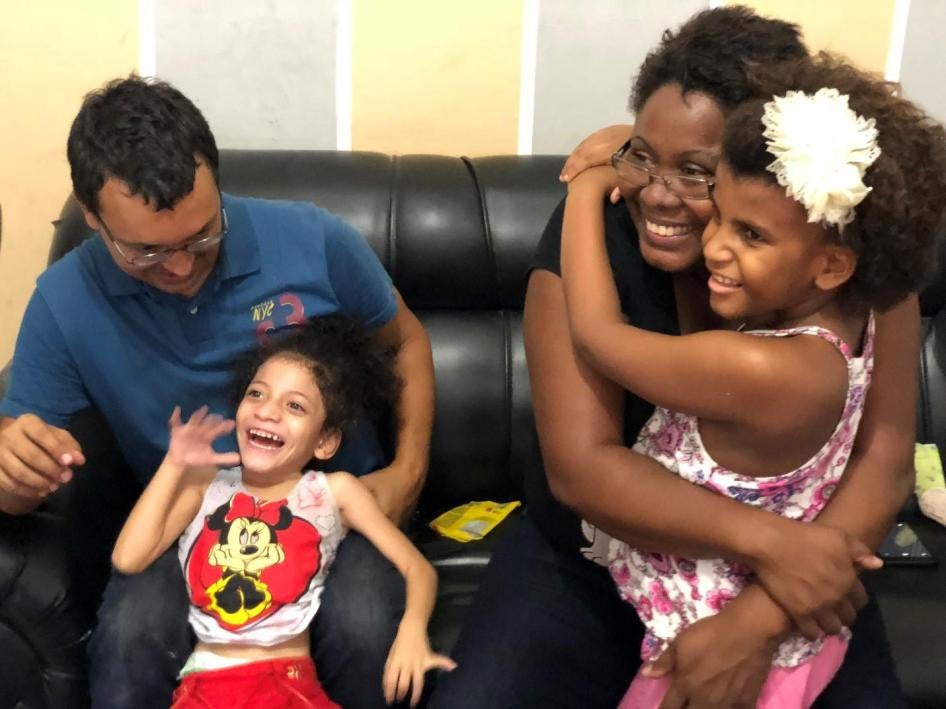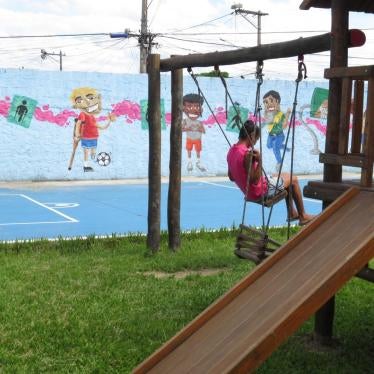Summary
Leonardo, 25, has muscular dystrophy, a disability that causes progressive weakness and loss of muscle mass. He has lived in a residential institution for persons with disabilities in Brazil since he was 15. His mother felt she had no choice but to place him there. “I suffered deeply when Leonardo had to be moved into the institution…, but I had no other alternative. The state doesn’t provide me with any support to care for him at home,” she said. Her hope was that the institution could care for him in a way she could not.
Leonardo shared a room with 24 other men and women with disabilities. Beds placed directly next to one another, without even a curtain for privacy. Leonardo had no control over his life, subject to the schedule and decisions of the institution. He remained stuck in bed most of the day, even for meals, with nothing meaningful to do:
I am placed in the wheelchair in the mornings, but I have to be put back to bed because … there is no one to put me back again in the evenings. I miss my home and would want to live with my mother, but I understand she is getting older and wouldn’t be able to support me physically.
In 2017, Leonardo moved back with his mother for a short period because the institution where he lived could no longer provide the specialized support he needed. By the end of 2018 he will move again to a different institution that is now under construction.
***
Leonardo’s experience is not unique. He is one of thousands of people in Brazil who live in residential institutions for people with disabilities. Most people enter as children and continue to live there as adults, some for their entire lives. In these institutions, children and adults may face neglect, inhumane conditions, and abuse, with little respect for their dignity and individual needs or preferences. Many adults in institutions are unlawfully detained in violation of Brazil's obligations international law because a guardian has placed them there, and they have no right to contest their institutionalization. The Brazilian government provides insufficient support for families of children with disabilities to raise their children at home and for adults with disabilities to live independently, which results in a reliance on institutionalization.
Under international law, governments must respect the inherent dignity of persons with disabilities by acknowledging them as persons on an equal basis with others. This includes recognizing people with disabilities have the right to live independently in the community and not segregated and confined in institutions, where they are subjected to control by others. Governments must also prevent discrimination and abuse against people with disabilities and remove barriers that prevent their full inclusion in society. All children, including children with disabilities, have a right to grow up in a family. No child should be separated from his or her parents because of a disability or poverty.
This report documents a range of abuses against children and adults with disabilities in residential institutions in Brazil. The research is based on direct observations during visits to 19 institutions (known in Brazil as shelters and care homes), including 8 for children, as well as 5 inclusive residences for people with disabilities. In addition, Human Rights Watch researchers interviewed 171 people, including children with disabilities and their families, adults with disabilities in institutions, disability rights advocates, representatives of non–governmental organizations, including disabled persons organizations, staff in institutions, and government officials. Research was carried out between November 2016 and March 2018 in the states of São Paulo (including São Paulo and Campinas), Rio de Janeiro (including Rio de Janeiro, Duque de Caxias, Niteroi and Nova Friburgo), Bahia (Salvador) and Distrito Federal (including Brasilia and Ceilândia).
Most of the people with disabilities living in institutions Human Rights Watch visited in Brazil were isolated from society and had little more than their most basic needs met, such as food and hygiene. Most lacked any meaningful control over their lives, bound by the institutional schedule and the demands of the staff. Many people were confined to their beds or rooms for extended periods of time or in some cases around the clock. They were not able to make simple every day choices that most people take for granted, such as what and when to eat, who to socialize with, what television program to watch, or whether to go out and participate in a leisure activity.
In eight of the institutions that Human Rights Watch visited, staff habitually restrained adults and children. In some cases, staff restrained adults to bed rails with pieces of cloth bound around their waists or their wrists. In two institutions, staff tightly bound socks or cloth around children’s hands to prevent them from putting their hands in their mouths or scratching themselves instead of implementing other methods, such as providing one-to-one personal support to prevent children from harming themselves. Staff in some institutions acknowledged that they gave adults and children medication to control their behavior, rather than for any legitimate medical purpose, without the adults’ consent. All restraints as a form of punishment, control, retaliation, or as a measure of convenience for staff should be prohibited.
Adults with disabilities in institutions had little to no privacy in 12 of the institutions visited. Up to 30 people lived in large wards or rooms with beds placed directly next to one another without a curtain or other separation. Some institutions had smaller rooms with fewer people in them, but also with limited privacy. Most adults and children with disabilities had few, if any, personal items, and in some cases were even forced to share clothes—and in one case even toothbrushes—with others in the institution. In one institution, staff did not provide women with sanitary pads during their monthly menstruation, offering only diapers. Staff in several institutions did not assist some adults to dress fully, such that adults wore only shirts or blouses and diapers. Human Rights Watch found that conditions and treatment were particularly bad in the institutions visited with large numbers of people with high support requirements. In some institutions for people with disabilities Human Rights Watch visited in Brazil, the conditions and treatment were inhumane and degrading.
In all adult institutions visited in Brazil, institution directors or staff members told Human Rights Watch that nearly all people living there had been stripped of their legal capacity, or the right to make decisions for themselves, and were under the guardianship of another person, either the institution director or a relative. Most people in institutions had been placed there by guardians and cannot leave, even for a short period, without the consent of the guardian. Adults with disabilities who are deprived of their legal capacity and placed in institutions on the basis of their disability against their will, either without their consent or with the consent of a guardian, are victims of detention that is unlawful under the international Convention on the Rights of People with Disabilities (CRPD), which Brazil ratified in 2008.
Carolina (not her real name), a 50-year-old woman with a physical disability, describes her experience in the institution when she spoke to Human Rights Watch:
This place is very bad, it is like a prison. I don’t want to stay here. I’m obliged to be here. My sons don’t want to support me at home. Although two of my sons come and visit me every two weeks, I never go outside. I would like to go out, away from here. It’s my dream. When you come like this [with a disability], it’s over.
Children and adults with disabilities alike had little or no meaningful activities inside the institutions we visited. Many lay in bed doing nothing or were placed in front of a television for hours on end. Insufficient staff meant that children with disabilities often lacked human contact on a regular basis. Few children with disabilities in institutions visited by Human Rights Watch attend neighborhood schools. Those who did have access to education typically received limited instruction in segregated settings.
The United Nations Children’s Fund (UNICEF), the World Health Organization, and decades of social science research have found that institutional environments can cause stunted physical, intellectual, emotional, and social development among children separated from families and placed in institutions due to lack of consistent caregiver input, inadequate stimulation, lack of rehabilitation, and other deprivations.
Although Brazilian law intends the placement of children in institutions to last no longer than 18 months, many children with disabilities are placed in institutions for much longer periods of time. In most institutions visited, staff told Human Rights Watch that the majority of the children have at least one living parent. Many children with disabilities lose contact with their families and remain segregated in institutions their entire lives. In one institution, for example, all 51 residents had been there since they were children. Several residents were over 50 years old. As the director of an institution in São Paulo said: “They stay until they die.”
According to data from the National Secretariat of Social Assistance, as of 2016, there were 5,078 children with disabilities living in institutions. This number likely underrepresents the actual number, as the data is based on self-reporting by institutions. According to the same data set, 5,037 adults with disabilities live in institutions.
In Brazil, institutions are often the only long-term housing options for many persons with disabilities. Insufficient alternative independent living arrangements and community-based support services to ensure adults with disabilities can live on their own, with support as necessary, prevent many adults from living in the community. Under the social assistance system in Brazil, persons with disabilities who cannot support themselves independently or with assistance from their families are entitled to receive a monthly benefit (Benefício de Prestação Continuada, BPC) of 954 Brazilian reals (US$259, at current exchange rates). Parents of children with disabilities interviewed by Human Rights Watch confirmed that their children require support beyond the BPC, including services that are not consistently provided by the state, or available in sufficient quantities, such as speech therapy, physical therapy, mobility devices, and access to day care centers.
Most of the staff Human Rights Watch spoke with in institutions were highly committed and motivated to support persons with disabilities. They frequently emphasized that they were doing the best they could to support persons with disabilities with the little resources they had. However, even very well-intentioned staff often engage in unacceptable practices because they lack information and training, and because of a shortage of adequate personnel and other resources to care for large numbers of people, especially residents who require more intense forms of support.
Government Response
Brazil has a strong legislative framework on the rights of children and in 2016 parliament adopted a groundbreaking Law on Inclusion (Statute of Persons with Disabilities), which harmonizes the country’s legislation with the CRPD. The law establishes a new, rights-based framework, including accessibility, education, political participation, and legal capacity, amongst other fundamental rights. The government also has in place several programs to support persons with disabilities, including financial assistance, which it should consider expanding and strengthening.
The government relies almost exclusively on private institutions to house children and adults with disabilities. Most of these institutions, including those Human Rights Watch visited, are facing significant financial hardship. Brazil is currently experiencing a severe financial crisis that has resulted in budgetary shortfalls and cuts, including cuts to social services. Some institutions have agreements with municipal or state agencies for funding; in some cases authorities have not delivered funds in a timely manner or have stopped funding institutions for extended periods of time. In other cases, institutions are expected to secure all funds independently through local or foreign donations.
Despite limited financial resources, the government and others who support institutions should look to responsibly reallocate expenditures to develop and expand accessible, quality-based community services. Research and practical experience in numerous countries has shown that support for services based in the community for people with disabilities, rather than concentrated in residential institutions, and are often no more expensive or not significantly more expensive than an institutionalized system.
Institutions in Brazil are licensed by the government. Judges, public prosecutors, and public defense lawyers visit institutions for children at least once every six months to review children’s placement in the institution. However, the state does not conduct regular monitoring of institutions for adults with disabilities. Although the law requires complaint mechanisms to be accessible to persons with disabilities, in practice they are not for people with various types of disabilities, making it difficult and in some cases impossible for them to file complaints about alleged abuses through existing channels.
One notable initiative underway in Brazil for people with disabilities is the inclusive residences program, which provides small group homes for up to 10 persons with disabilities, who have moved out of large institutions. Human Rights Watch visited five inclusive residences. This program may serve as a good first step toward enabling persons with disabilities to exercise their right to live independently. However, as they currently function, the residences do not fully ensure this right. As in institutions, residents do not have control over their lives, such as with whom to live or whether to live in the inclusive residence at all.
Inclusive residences may be useful in the short term as Brazil transitions away from large residential institutions, but they should not be seen as an alternative to programs that afford persons with disabilities the possibility of truly independent living, which can be facilitated by a range of in-home, residential, and other community support services, including personal assistance if necessary. The Brazilian government is also developing foster care and adoption programs for children, which should be expanded and fully include children with disabilities on an equal basis with all other children.
Recommendations and the Way Forward
As a matter of priority, the Brazilian government should:
- Develop a time-bound plan to phase out the use of residential institutions for children and adults and develop community-based services for individuals with disabilities and families of children with disabilities. This should include efforts to reallocate expenditures and other government programming away from institutions and toward increased supports to people with disabilities to live independently in their communities and for families to raise children with disabilities at home.
- End abuses against adults and children with disabilities in institutions. The government of Brazil should create an inter-agency task force bringing together relevant authorities, including state prosecutors, and agencies at various levels to systematically monitor institutions, prevent and remedy human rights abuses, including concerns such as restraints used as punishment, control, retaliation or as a measure of convenience for staff; medication without consent and without clear medical purpose; and neglect. Ensure accessible complaint mechanisms.
- In addition to the BPC benefit, ensure quality, accessible services for independent living for children and adults with disabilities according to their individual requirements, including personal assistance services, as well as targeted services based on the specific needs of the individual. Prioritize family-based care for children with disabilities on an equal basis with others, including by supporting families, including foster and adoptive families, with children with disabilities to raise them in the community.
- Guarantee quality, inclusive education for children with disabilities living in institutions in mainstream schools, on an equal basis with others, and provide reasonable accommodations based on individual learning requirements.
- Build upon the inclusive residences program to ensure they facilitate independent living, including essential life skills, of people with disabilities living there, rather than serve as substitute institutions. All residents should be there voluntarily, be allowed autonomy, and participate in the management of the residence.
- Ensure that no adult person with a disability is deprived of legal capacity. Amend laws to remove the system of guardianship on the basis of disability and replace it with an effective system of supported decision making. This means ensuring that persons with disabilities receive the support they need to make choices and direct their own lives, including for medical treatment, parenthood, relationships, and living arrangements.
Methodology
Research for this report was conducted in November 2016 and March 2018 in the following locations in Brazil: São Paulo (including São Paulo and Campinas), Rio de Janeiro (including Rio de Janeiro, Duque de Caxias, Niteroi, and Nova Friburgo), Bahia (Salvador) and Distrito Federal (including Brasilia and Ceilândia).
São Paulo, Rio de Janeiro, and Bahia were selected because they have some of the highest concentration of residential institutions, including for people with disabilities, nursing homes, foster families, and other social welfare programs in Brazil. São Paulo has 1,586 such facilities and programs; Rio de Janeiro has 359; Bahia has 261, and Federal District 40.[1] Brasilia was also chosen because it is part of the Federal District and the location of federal authorities responsible for developing national policies, including for adults and children with disabilities.
This report is based on 171 interviews carried out in Brazil and by telephone preceding and following field research. Human Rights Watch interviewed 10 children, ages 10 to 18, and 50 adults with disabilities in residential institutions, 26 of them women. Other interviewees included 12 parents or other family members; 50 government officials (including heads of secretariats in the areas of social assistance, childhood and disability, members of congress, judges, state and federal prosecutors, state public defenders, members of councils for children, members of guardian councils, and legal advisors); 35 institution staff members; and 17 representatives of non-governmental organizations or disability rights advocates. Whenever possible, Human Rights Watch spoke directly with children and adults with disabilities.
Human Rights Watch visited 19 residential institutions for people with disabilities in Brazil, including 11 for adults; 8 for children (five of which were specifically for children with disabilities); one medical facility for children with disabilities. We also visited 5 inclusive residences for people with disabilities. We made 7 visits in Rio de Janeiro; 5 in São Paulo; 6 in the Federal District; and 6 in Bahia. We also visited two day care centers for children and adults with disabilities, where people visit during the day and return to their homes to spend the night.
For the purposes of this report we use the term “institution” to refer to three types of institutions for people with disabilities Human Rights Watch visited: institutional shelters, care homes, long-stay hospitals, and facilities that are hybrids of these types of facilities.
The children and adults interviewed had a range of disabilities including physical, sensory (blind, deaf, and deafblind), learning, intellectual, and psychosocial disabilities. Some children and adults had multiple disabilities.
In this report, “child” and “children” are used to refer to anyone under the age of 18, consistent with usage under international law. Brazilian law defines children as anyone under 12 years old and children between 12 and 18 as adolescents.
Interviews with government officials were conducted in English with interpretation into Portuguese, or in Spanish, with the respondent speaking in Portuguese. Interviews with children and adults with disabilities were conducted in English and Spanish with interpretation into Portuguese.
In order to protect the privacy and confidentiality of the people we interviewed, we do not name the institutions we visited, and we have used pseudonyms for most people interviewed for this report.
For each interview, we explained our work in age-appropriate terms when needed. Before each interview, we informed potential participants of the purpose of the research and asked whether they wanted to participate. We informed participants that they could discontinue the interview at any time or decline to answer any specific questions without consequence. Interviewers told interviewees that they were free to not answer any questions.
Human Rights Watch interviewed children with disabilities in an age-appropriate and sensitive manner and ensured that the interview took place in a location where the interviewee’s privacy was protected.
Human Rights Watch also consulted national and international disability rights experts at various stages of research and writing. We also reviewed official documents, in particular legislation on social assistance, children and disability issues, and relevant reports and resolutions from United Nations treaty bodies, Inter-American human rights bodies, experts, and nongovernmental organizations.
Human Rights Watch sent letters to numerous government agencies regarding the concerns detailed in this report, including the Ministry of Social Development, the Ministry of Human Rights, the National Council of Prosecutors’ Offices, as well as Attorneys General and state and municipal authorities responsible for social assistance and the rights of people with disabilities in the four states where we did research. These agencies responded: the Ministry for Social Development, the National Council of Prosecutors’ Offices, the São Paulo Prosecutor’s Office, the São Paulo Municipal Secretariat of Social Assistance and Development , the Rio de Janeiro State Prosecutor’s Office Rio de Janeiro Municipal Secretary of Science, Technology, Innovation and Social Development, Foundation of Childhood and Adolescence. A full list of agencies and responses can be found in the annex to the online version of this report.
I. Background
Children and Adults in Institutions
According to official 2016 data of the National Secretariat of Social Assistance under the Ministry of Social Development, there are approximately 5,078 children with disabilities living in institutions.[2] However, there are flaws in Brazil’s collection of data on children living in institutions and these figures are likely to underestimate the total numbers.[3] As of December 2016, 5,037 adults with disabilities were in institutions and inclusive residences for persons with disabilities.[4]
Numbers and Types of Institutions
There are 2,998 institutions for children in Brazil, of which, 2,537 admit children with disabilities, including 35 institutions exclusively for children with disabilities.[5] There are two main types. Institutional shelters (abrigo institucionais) should house no more than 20 children with professional staff who work in shifts.[6] There are also smaller homes for children (casa-Lar), designed for a maximum of 10 children, and aim to simulate a family setting with a person known as an educator living full time in a house with the children. [7] There are 258 residential institutions for adults with disabilities in Brazil, including institutional shelters (abrigo) and inclusive residences.[8] In addition there are other types of facilities in the healthcare system where persons with disabilities, including children and older persons, live for extended periods.[9]
Judges determine the placement of children in institutions based on a petition from the Public Prosecutor’s Office, including upon a request from the Guardian Council for Children (Conselho Tutelar), to apply a protective measure in cases where a child is at risk or when his or her rights have been violated (abandonment, neglect or violence) and it is not possible for the family to provide care.[10] The Secretariat of Social Assistance at the state and municipal level and private organizations that run institutions are obligated to comply with judicial orders for each child.
Adults with disabilities often end up in institutions because they grow up in them beginning in childhood and then remain there or are transferred to an adult institution. An adult with a disability can also be placed in an institution by a relative or institution director who has guardianship over him or her, as described in more detail below.
State and municipal governments administer some institutions for people with disabilities, but most are privately run by non-profit organizations. Funding for institutions comes from various sources, including states and municipalities, religious groups, and private foundations, and individuals, including from foreign countries. According to 2016 data, 32 institutions for children with disabilities, a small number of the total institutions, received public funding, mainly from municipalities. Among institutions for adults, 201 received government funding.[11]
Harms of Institutionalization for Children
Numerous observational studies have demonstrated that placing children in institutional settings, irrespective of their material conditions, is detrimental to their emotional, cognitive, physical, and social development when care is provided focusing only on basic needs without a one-to-one relationship.[12] UNICEF has found that institutional environments can cause “developmental delays and irreversible psychological damage due to lack of consistent caregiver input, inadequate stimulation, lack of rehabilitation and poor nutrition.” Many children with disabilities require access to additional learning opportunities or specialized services like rehabilitation, which are often lacking in institutional settings.[13]
Child development specialists have found that the institutionalization of babies harms their early brain development and puts them at risk of attachment disorder, developmental delay, and neural atrophy.[14] For older children, the UN Committee on the Rights of the Child has noted, “There is significant evidence of poor outcomes for adolescents in large long-term institutions... These adolescents experience lower educational attainment, dependency on social welfare, and higher risk of homelessness, imprisonment, unwanted pregnancy, early parenthood, substance misuse, self-harm, and suicide.”[15]
Studies have shown that children moved from an institution into family-based environments demonstrated signs of improvement in their intellectual functioning, attachment patterns, reduced signs of emotional withdrawal, and reduced prevalence of mental health conditions.[16] One institution director in Brazil confirmed: “When a child from an institution goes back to the family or is adopted, you can see how development improves quickly, it’s visible.”[17]
II. Treatment and Conditions in Institutions
Human Rights Watch visited 19 institutions in Brazil in four states, including 11 institutions for adults with disabilities and 8 institutions for children, including 5 exclusively for children with disabilities.[18] All adult institutions also had children, and some of the specialized institutions for children with disabilities also housed adults.
Institutions ranged in size from 20 to 110 persons. Most institutions had approximately 30 to 50 people. In several institutions, Human Rights Watch documented abuses including ill-treatment, neglect, the use of restraints to control or punish residents, sedation, as well as inhumane and degrading conditions. Conditions and treatment were particularly abusive in the institutions we visited that had large numbers of people with high support requirements.
Many institution managers claimed that they did not have adequate staff to provide individualized attention to residents. For children, research has shown that the absence of a one-to-one relationship with a primary caregiver is a major cause of harm to a child’s development and attachment disorders. Most children with disabilities in institutions did not go to school. For those who did receive education, it was not meaningful to develop academic or life skills and took place primarily in segregated settings.
Most of the staff Human Rights Watch spoke with in institutions were highly committed and motivated to support persons with disabilities. They frequently emphasized that they were doing the best they could with the little resources they had. However, even well-intentioned staff often engage in unacceptable practices because they lack information, training, as well as resources, such as additional personnel, to help them care for large numbers of people, especially those requiring more intense forms of support.
People with disabilities have the right, on an equal basis with others, to be free of inhuman and degrading treatment as well as not to be subjected to forced medical treatment or restraints. Children enjoy this same right, as well as the right to education, play, and leisure.
Use of Restraints and Isolation
In eight of the 19 institutions that Human Rights Watch visited which held more than 50 residents, staff restrained adults and children in various ways. Staff restrained residents to bed rails with pieces of cloth bound around their waists or their wrists. In two institutions, Human Rights Watch saw how staff tightly bound socks or cloth around children’s hands to prevent them from putting their hands in their mouths or scratching themselves.
In one institution, staff told Human Rights Watch that “at times we use straitjackets and placed people in an isolation room for them to calm down.” A nurse said, “Sometimes we … restrain them with sheets, or we use straitjackets for about 30 minutes while waiting for medication to take effect.”[19]
Staff at some facilities stated that they restrained individuals in order for them not to hurt themselves.[20] Staff in institutions Human Rights Watch visited in Brazil appear to rely on restraints because there are not enough personnel to allow them to give individuals the attention and support required to help them manage behavior that could be harmful.[21] Although the government has issued technical guidelines for staffing levels in institutions for children, they are non-binding. There are no guidelines for staffing for adult institutions (abrigos-institucionai).[22] In one institution in Rio de Janeiro only four staff members at a time provided direct support to 51 adult residents, all with high support needs.
Restraint is never acceptable as a means of punishment or behavior control and it could amount to torture or ill-treatment. The special rapporteur on torture has stated that “any restraint on persons with disabilities for even a short period of time may constitute torture and ill-treatment.”[23]
The World Health Organization (WHO) has found that aggressiveness and unwanted behavior can often arise when individuals are constrained by the inherently rigid nature of the institution that does not give adequate attention to an individual’s will and requirements.[24] The WHO is designing programs to train staff to prevent situations that can escalate into aggressiveness, violence, and behavior that could result in self-harm. One key element is creating an institutional environment that recognizes individual needs and requirements and provides services in a timely and dignified manner. Other alternatives are designing individualized plans to understand and recognize triggers, early warnings, and tense situations.[25] The Brazilian government should move quickly to implement these types of measures while working towards deinstitutionalization.
Confinement to Beds and Rooms
Human Rights Watch visited eight institutions where residents remained in their beds or rooms continuously or for extended periods of time, including for meals. In five adult institutions, metal beds had tall metal bars to confine some residents with intellectual disabilities.
Many people whom staff considered “severely disabled” (muito comprometidos), especially those who had multiple disabilities and could not move by themselves, remained almost continuously in their beds, lying down, doing nothing. At the time of Human Rights Watch’s visit to one institution, 32 residents, both children and adults, were all lying in their beds or cribs.[26] In one institution, a staff member confirmed that residents with high support needs lay down almost continuously, being brought out of bed and placed in a wheelchair only for short periods.[27] In one of the institutions Human Rights Watch visited in Rio de Janeiro, dozens of people with so-called “severe” disabilities were separated on the upper floor of the building. Up to eight people lived in small rooms, some of them restrained to metal bars of the bed by a cloth around their waists. A nurse in this institution said that people there “never leave the room.”[28]
A specialized institution for persons with cerebral palsy in São Paulo had a ward for persons with high support requirements, where people lay in bed almost continuously, connected to oxygen tanks in the wall through tubes. According to one staff member, residents sat in wheelchairs for some hours during the mornings but had limited other activity. They never left the institution.[29] In Salvador, in one institution for 87 people, some people lay in bed constantly without stimulation or activity; another institution for 109 children had one room with children who similarly lay in beds continuously.[30]
In some institutions, most residents wore diapers and did not even get out of bed to use the toilet. A nurse in one institution told us, “All people who live in this ward use diapers.”[31] The parent of one resident told Human Rights Watch that she believed some residents, including her son, could use toilets if proper support was provided.[32]
Human Rights Watch observed that, except for wheelchairs in some cases, there were no other mobility devices like hoists or other instruments of any kind in any of the institutions visited to enable persons with physical disabilities to get out of their beds, much less to go out of the institution. Residents were not able to get up and walk without such assistance were completely dependent on the staff.
For example, Leonardo Barcellos, a 25-year-old with muscular dystrophy, was placed in an institution for people with high support needs when he was 15. He lived in one large room, along with 24 other men and women. He told Human Rights Watch that he spends large parts of his day in bed due to the lack of personnel to move him:
I am placed in the wheelchair in the morning, but then I have to be put back into my bed because I’m heavy, and there is no one to put me back again in the evenings. I miss my home and would want to live with my mother, but I understand she is getting older and wouldn’t be able to support me physically.[33]
In one institution in Salvador, an 18-year-old man with a progressive disability, which gradually compromised the muscles in his legs, had difficulty getting out of the room he shared with one other person. He did not have a wheelchair and moving on his own was extremely painful. Although the institution was located just 200 meters from the sea, he was unable to go to the beach and told Human Rights Watch that his dream was to “see the sea.”[34]
Inhumane and Degrading Conditions
Most of the large institutions had an impersonal and hospital-like or detention center-like environment. In some institutions, doors and windows had bars on them, giving them the appearance of detention centers. Conditions in institutions in Brazil that Human Rights Watch visited were often dehumanizing. In some cases, large numbers of unrelated adults or children were kept in rooms together, sometimes in severely crowded rooms of up to 32 people. In addition to being confined to the institution, many people remained in their rooms or beds for most or all of the day either because they were restrained to the beds or because staff did not provide support for people to leave their beds.
Residents overwhelmingly had no privacy and had few or no personal items. In some cases, they even had to share clothes—and in one facility, even toothbrushes—with others. In some adult institutions staff did not assist residents to get dressed, leaving them unclothed from the waist down, wearing only diapers. Several institutions advertised tours for the public and solicited donations online relying on images of persons with disabilities as needy, vulnerable, and in need of care, rather than as autonomous individuals. In many of the institutions visited by Human Rights Watch, the problems described below created an inhumane and degrading living environment for residents.
Overcrowding and Lack of Privacy
Serious overcrowding was a problem in a number of institutions visited by Human Rights Watch. For example, in a Salvador institution for 109 children, one room held about 28 beds in four rows placed side by side with very little room to move between the rows and with no separation between beds to provide basic privacy. In one institution for adults 32 people lived in one room, again with beds placed directly next to each other. Some institutions had large wards with only small walls that separated groups of six to seven people. At least one staff member was constantly present. One of these overcrowded institutions had a bathroom where there were no doors or other means of privacy separating the toilets.
In five institutions visited, people slept in rooms with nothing but a bed (or multiple beds) or a mattress on a concrete platform.[35] In one case people lay on mattresses on floors. The director of that facility claimed that the beds were being painted. Some slept on bare mattresses with no bottom sheet, but only a sheet to cover them. There was no other furniture that might be found in a bedroom, such as a bedside table, shelves for personal belongings, or dressers or bureaus for clothing.
In some institutions visited by Human Rights Watch, residents did not have any personal items.[36] In one institution a nurse told us, “We don’t have separate toothbrushes for each of them. They share.”[37] In some institutions staff stated that people living there were required to share clothes.[38]
International human rights law requires that all persons with disabilities be treated with dignity. Respecting the inherent dignity of persons with disability entails acknowledging them as persons on an equal basis with others and not as objects of treatment and care.[39] International law also establishes the right to privacy, including for people with disabilities on an equal basis with others. This applies regardless of their place of residence or living arrangements.[40]
Failure to Assist Adults with Dressing and Lack of Privacy When Changing Diapers
Human Rights Watch visited seven institutions in all municipalities where staff did not support adults deemed to have “severe disabilities” to dress fully. As a result, these residents only wore clothes on the upper halves of their bodies, wearing nothing below the waist except a diaper. This is done for the convenience of staff members when changing peoples’ diapers. In addition, because beds are placed directly next to each other without any separation, staff changed residents’ diapers in full view of other adults.
Staff in one institution said that diapers were in short supply with only two diapers per adult or child per day. As a result, some residents had to remain in their own waste for long periods of time. Female residents in the same institution are not provided with sanitary pads for menstruation, “so we use diapers instead,” according to one nurse.[41]
Human Rights Watch considers the failure to fully dress residents and the failure to ensure privacy when changing adult diapers to potentially rise to the level of degrading treatment. The failure to provide women with sanitary pads for menstruation is dehumanizing.
Neglect and Lack of Meaningful Activities in Institutions
In all institutions that Human Rights Watch visited, children and adults with disabilities lacked sufficient personal attention and meaningful activities. Overwhelmingly, institution staff stated that they did not provide individual attention to residents, due to the large number of residents and lack of sufficient personnel to work directly with them. Staff said that they focused almost exclusively on basic care, such as feeding, toileting, and managing sleep routines, with time only for occasional leisure activities. Human Rights Watch’s observations in institutions confirmed few staff caring for large numbers of residents at one time, with little time except to meet residents’ basic needs. As noted above, lack of sufficient personal attention and consideration of individual needs can contribute to aggression, self-harm, and other undesirable behaviors.
A staff member in one of the institutions said that children there are deprived of personal contact. She said, “We cannot give them that. They need to be held, but we don’t have time to hold them.” She continued:
The main [issue] is individualized care.… In many institutions, they only provide food and a bed. Kids don’t spend time playing. Caregivers are only concerned to give food and put them to sleep. There is no affection, no play. Life is not only eating and sleeping.[42]
In many institutions which Human Rights Watch visited, some or most residents, both adults and children, were just staring at whatever was in front of them without engaging in any activity. This was true in all 10 institutions for adults Human Rights Watch visited.
In one institution for example, which Human Rights Watch visited at noon, all 32 residents were sitting or lying down in a large, dark room doing nothing. Staff explained that they turned off the lights regularly because of the heat.
At the time of Human Rights Watch’s visit to a special institution for children with disabilities in Rio de Janeiro in the middle of the day, all 12 children living there were lying in their cribs without anything to engage them. [43] In five institutions in Rio de Janeiro and São Paulo, staff placed children in front of the television to watch whatever program was on.[44] In one institution visited, dozens of children under the age of 10 were placed in front of a television for the entire time of Human Rights Watch’s four- hour visit.[45]
Some activities were organized within the institutions for children and adults, including by bringing in outside groups to provide entertainment. For example, a group of volunteers dressed as clowns makes periodic visits to the institutions to entertain residents.
Staff in some residences said that they occasionally organize trips outside of the institution to the beach, the movies, and other activities. However, in some institutions these trips are rare and in others nonexistent.
One teenager with a physical disability living in a special institution for children with disabilities said:
The institution is stressful because it is noisy and boring. Often I have nothing to do when I'm not at school. I don’t have privacy or a space for myself. Special day trips are only organized during weekends, but the staff member in charge of taking us out had an accident and injured herself, so we are not currently going out at all.”[46]
The Convention on the Rights of the Child (CRC) establishes the right of children to engage in play and recreational activities appropriate to their age.[47] The CRPD establishes the right of children with disabilities to have equal access with other children to participation in play, recreation and leisure, and sporting activities.[48]
Institution Fundraising Based on Negative Stereotypes of People with Disabilities
Many private institutions for persons with disabilities, including those visited by Human Rights Watch, promote tours and encourage donations. They advertise tours on their websites and through social media, such as Facebook. [49] One institution advertised tours for the public of up to five people twice a day; groups of over five people could be arranged on Saturday. Visitors can take photos and videos with authorization. The website tells visitors to take care when speaking with institution residents because they are “sensitive persons and that sometimes they fantasize.”[50]
Human Rights Watch also examined the websites of eight other institutions which had similar videos and appeals. The institution websites viewed by Human Rights Watch foster a negative image of persons with disabilities and perpetuate and reproduce stigmas by portraying institution residents as vulnerable and needy rather than as autonomous persons whose individual choices and inherent dignity must be respected.
The CRPD obligates governments to combat stereotypes, prejudice, and harmful practices relating to persons with disabilities, including by encouraging all organs of the media, as well as social media, to portray persons with disabilities in a manner consistent with the purpose of the CRPD.[51] The CRPD committee has stressed, in numerous concluding observations regarding states compliance with the convention, that charitable campaigns that stereotype persons with disabilities as objects of charity are incompatible with the objective and purpose of the CRPD.[52]
|
Involuntary and Potentially Inappropriate Use of Psychoactive Medications Although our research did not focus on inappropriate medication of people with disabilities living in institutions, we encountered several examples of residents whom the staff said were drugged to control their behavior. Staff at several institutions confirmed that they put residents on psychoactive medications without seeking their consent. The use of medications as chemical restraints to control residents’ behavior—for staff convenience or as punishment—violates international human rights standards. In March 2017, Human Rights Watch researchers encountered a 19-year-old man with an intellectual disability lying motionless on a mattress in the middle of the day in a noisy institution. The institution’s director explained that staff had given him sedatives because he had bitten people.[53] She said that 12 of the 24 residents in the institution were on Risperdone, prescribed by a doctor, an antipsychotic medication that was developed to treat schizophrenia. Not all of the patients had schizophrenia. The facility had not sought informed consent from the residents for the use of the medications.[54] Staff at several other institutions said that they use psychoactive medications to control resident behavior as well. A nurse in an adult institution stated, “If the residents misbehave they are given medication.”Another staff member in the same institution said, “In order to control them, we sedate them; some of them are given sleeping pills.”[55] In another adult institution, Human Rights Watch visited a ward with eight people, where medical staff said they gave medication to residents to “make them stable, to control crises, or to sedate them.” One staff member said, “If we don’t medicate them they become aggressive.”[56] A rigid institutional routine, confinement, the lack of meaningful activities, and frequent lack of recognition of the individual will and preferences of residents in institutions can trigger aggressive behavior.[57] While staff at institutions need to ensure that the environment in the facility is safe for residents and staff, drugging of residents for behavior control is not appropriate. Brazil should review its procedures for the use of psychoactive medications in institutions to ban their use as chemical restraints and ensure adequate oversight to enforce this ban. Staff in most institutions visited stated that they regularly gave medicines to adults without their consent. In one institution in Rio de Janeiro, the director said, “We don’t ask for consent because these are persons who have severe disabilities. They don’t speak, they don’t think.”[58] For adults, medications should be delivered with the consent of the individual being treated. The CRPD Committee has held that treating an adult with medications without consent is a violation of the right to equal recognition before the law and an infringement of the right to personal integrity; freedom from torture and inhuman and degrading treatment; and freedom from violent exploitation and abuse.[59] Informed consent can be achieved through supported-decision making. Brazil’s law on inclusion establishes a general framework to implement supported decision-making. It should be further developed by establishing accessibility measures and reasonable accommodation (plain language and alternative forms of communication) and advance directives in the appointment of one or more persons who will provide support chosen by the person concerned. See also, below, on Legal Capacity. For children, consent should be given by the guardian, in consultation with the child, and used only for the therapeutic purposes and consistent with the right to the highest attainable standard of health. |
Inadequate Education
Human Rights Watch found that education for persons with disabilities in the institutions we visited was limited. The majority of people with intellectual disabilities or who could not communicate received no education at all. Brazil’s 2016 Statute for People with Disabilities states that people with disabilities have the right to education and to be provided with support and reasonable accommodations without extra cost in regular schools regardless of where they live.[60]
In four institutions visited in Rio de Janeiro for children and adults with disabilities, residents with intellectual disabilities and other disabilities which required high support, did not receive any education. In São Paulo, Human Rights Watch visited two institutions for children with disabilities with high support requirements; none of them received education. In an institution for 49 children and adults with intellectual and multiple disabilities in Ceilândia, one person was going to a regular school, the others had not received any schooling. In Bahia, Human Rights Watch visited an institution with 87 children and adults; none of whom received any education.[61] In a second large institution in Bahia of 109 children with disabilities, 37 children, either with autism or high support requirements, or both, did not receive any education.[62]
The São Paulo’s Public Prosecutor’s Office’s inquiry in 2016 into 16 specialized institutions for children with disabilities in the municipality found that two-thirds of the institutions had no relationship with educational services..[63]
In the institutions visited by Human Rights Watch, only children whom the institution staff determine have some level of autonomy can attend school. Children with disabilities living in general institutions or who do not have intellectual disabilities are regularly sent to local mainstream schools in local communities. In some cases, children from institutions also attend special schools in the community that are exclusively for children with disabilities rather than in mainstream schools for all children. Some institutions provide children with intellectual or sensory disabilities special education programs within the institution, which has no official status as an educational facility. Children receive a certificate that is not an official diploma and would not allow an individual to continue his or her education elsewhere.
Throughout the interviews Human Rights Watch conducted with institution staff and other government officials, there was a clear tendency to classify persons according to what staff believed was a child’s “level of disability,” which ranged from moderate to severe. According to staff, in most institutions visited and some policymakers interviewed by Human Rights Watch, those who were deemed to have “severe disabilities” (muito comprometidos) were considered not capable of being educated.[64] Alberto, a 52-year-old man with a physical disability, institutionalized for 40 years, said that he only completed first grade, “I have been living here since I was 12. I managed to study until first grade of primary school. I’m interested in studying physics.”[65]
Mariana, an 18-year-old blind woman, had been living in an institution since she was 12 and remained there as the institution was transformed into an inclusive residence. She told Human Rights Watch that she did not know how to read and write and only recently began learning to use braille at the Institute for the Blind in Bahia. She told Human Rights Watch that she wanted to work as a professor or as a physiotherapist.[66]
Clementina Bagno, member of the Guardian Council for Children (Conselho Tutelar) in Brasilia, confirmed that:
General education policies do not consider the requirements of people with disabilities who are living in institutions which leads to their exclusion and marginalization.[67]
The CRPD requires state parties to ensure the right of persons with disabilities to education without discrimination and on an equal basis with others through inclusive education at all levels: preschool, primary, secondary, and tertiary school, vocational training and lifelong learning, and extracurricular and social activities.[68] The CRPD prohibits excluding persons from the educational system on the basis of their so-called “level of disability.” No formal or informal evaluation should be made to determine if a child or an adult with a disability is capable of being educated in the general education system.[69] Any evaluation should have the purpose of assessing the specific requirements a person needs to fully support him or her in the general education system. The CRC also establishes the right of every child to education.[70] In its 2015 review of Brazil, the CRPD Committee expressed concern about children with disabilities being refused admission to schools or charged extra fees as well as the lack of reasonable accommodation and accessible school environments in the mainstream education system.[71]
An arbitrary determination that a child can or cannot benefit from educational services based on the alleged level of autonomy or disability constitutes discrimination. The state has the obligation to ensure that private persons, included nonprofit organizations, do not discriminate against persons with disabilities, including based on assumptions about their ability to be educated.[72]
|
“Muito Comprometido”? “Severe disability” has no definition
Throughout this research Human Rights Watch conducted in Brazil, public officials and institution staff consistently referred to people with certain types of disabilities or with multiple disabilities as having “severe disabilities” (muito comprometido). This was usually in reference to people who could not communicate, had difficulties understanding and self-functioning, had medical conditions that required intense support, or had multiple disabilities. Many officials and institution staff seemed essentially to justify a lack of enjoyment of rights and services by certain people, based on this vague and essentially arbitrary concept of “severe disabilities.” The term as they applied it has no clear meaning, and instead seemed to represent a subjective and careless effort to create a category of people who can be stripped of their autonomy and rights. International human rights law protects all persons with disabilities, regardless of the so-called “level of impairment.” |
Lack of Accessibility in Children’s Institutions
Although children with disabilities are placed in institutions, including general institutions for children, for long periods of time, all three general children’s institutions visited by Human Rights Watch lacked an accessible physical environment for people with disabilities. In one institution in São Paulo, for example, stairs at the entrance made it impossible for a child with physical disability to enter or exit independently.[73] One institution in Salvador had only one bathroom with enough space for a wheelchair to fit, but it was in the girls’ section.[74] No bathroom in any general institution was fully accessible with toilets with raised toilet seats and support bars.
According to the Technical Guidelines: Reception Services for Children and Adolescents in Brazil, institutions for children should be managed based on the principle of inclusion.[75] However, 2016 national survey shows that of the nearly 3,000 institutions for children and adolescents throughout Brazil, only 584 have accessible entrances, 767 are accessible in the bedrooms and spaces for common use, and 539 have accessible bathrooms.[76]
III. Prolonged and Life-Long Institutionalization for People with Disabilities
Staff members of different institutions, institution residents, and experts all told Human Rights Watch that children with disabilities whose families are unable to care for them are often placed in institutions for extended periods. Children with disabilities placed in institutions remain there longer than other children and often remain as adults, sometimes for their whole lives. Some institution staff told Human Rights Watch that children frequently lose contact with their families.[77] As the director of an institution for adults with disabilities in São Paulo, told Human Rights Watch people living in institutions “stay until they die.”[78] Some institution directors told Human Rights Watch that few residents ever leave the institutions once they have entered. An ongoing civil inquiry into conditions in 16 institutions in São Paulo by the local Public Prosecutor's Office confirms that few people leave institutions. In the last 10 years, just over 500 people left the 16 institutions; half due to death and 77 transfers to other institutions. In the remaining cases, children were adopted, or adults and children returned to their families.[79]
Adults with disabilities who are deprived of their legal capacity, or the right to make decisions for themselves, and placed in institutions on the basis of their disability against their will are victims of unlawful deprivation of liberty under the CRPD.
Human rights law recognizes the equal right of all persons with disabilities to live independently and be included in the community with the freedom to choose and control their lives. This right is founded on the core human rights principle that all human beings are born equal in dignity and rights and all life is of equal worth.[80] People with disabilities should not be isolated from society, such as in Brazil’s institutions.
The CRPD Committee has stated that the “systematic realization of the right to independent living in the community requires structural changes,” including phasing out institutionalization. The committee’s guidance states that “no new institutions may be built by States parties, nor may old institutions be renovated beyond the most urgent measures necessary to safeguard residents’ physical safety. Institutions should not be extended [and] new residents should not enter in place of those that leave.” In conjunction with deinstitutionalization, states must provide a range of individualized support services which allow for personal choice and self-control. The aim of these individualized support services is the realization of full inclusion of persons with disabilities in society and preventing isolation and segregation from others within the community.[81]
For children, Brazilian law states that placement of children in institutions can only be determined by a judge and should be an exceptional and temporary protective measure, only taken when a child’s rights are in danger and no alternative means to remedy the situation are available. A specialized judge on children determines the protective measures for the child. Placement in an institution should be reviewed every six months[82] and preferably should not go beyond 18 months.[83] However, this limit is not always respected, particularly for children with disabilities. One public defender in Rio de Janeiro told Human Rights Watch, “When it comes to children with disabilities, the [18 month] limit is just a general recommendation, it is often longer in reality.”[84]
The CRC, CRPD, and the American Convention on Human Rights, to which Brazil is also a party, acknowledge that the family is the natural environment for the growth and well-being of all its members, particularly children, and including children with disabilities.[85] States should also ensure that children are not separated from their parents against their will unless that separation lies in the child’s “best interests.”[86]
The United Nations Guidelines for the Alternative Care of Children additionally state that financial and material poverty should never be the only justification for the removal of a child from parental care, for receiving a child into alternative care, or for preventing his/her reintegration, but should be seen as a signal for the need to provide appropriate support to the family.”[87] The CRPD states that a child should never be separated from his or her parents against their will except when a judicial authority determines that this is in the best interest of the child—and never on the basis of the child’s or a parent’s disability. When immediate families cannot care for a child with disabilities, states should “undertake every effort to provide alternative care with the wider family, and failing that, within the community in a family setting.”[88]
Both the CRC and CRPD Committees have encouraged states to establish programs to move children with disabilities out of institutions, also known as deinstitutionalization, returning them to their biological or extended families or placing them in foster or adoptive care. This includes providing children and their families with adequate community-based supports, as described in more detail below.[89]
In its 2015 review of Brazil, the UN Committee on the Rights of Persons with Disabilities, the expert body which monitors implementation of the treaty, expressed its concern about the lack of access to support services, especially personal assistance services aimed at enabling persons with disabilities to live independently and be included in the community. The Committee called on Brazil to develop and implement a deinstitutionalization and community-based living strategy with clear time frames and benchmarks, in consultation with organizations of persons with disabilities.[90]
Children with Disabilities Remain in Institutions for Long Periods
According to the 2016 survey of institutions, more than 60 percent of children with disabilities in institutions have been living there for more than six years, compared to 5.7 percent of children without disabilities in institutions. For adults with disabilities, almost 62 percent have been in institutions for more than six years. [91]
Similarly, a 2008 study on children with disabilities in institutions in Rio de Janeiro found that children with disabilities typically live in institutions for long periods of time, including up to more than half of their lives. Children with disabilities do not participate in public life and have their social and family bonds broken or weakened.[92]
Finally, a study carried out by order of the National Council of the Public Prosecutor’s Office in 2013 confirms that for children with disabilities, institutions are not fulfilling their objectives. Institutions are supposed to be provisional settings for children, but they become permanent homes for those with disabilities. The study shows that what was initially intended as provisional placement has transformed into confinement for children with disabilities.[93]
Entering as Children, Remaining as Adults
In seven institutions visited by Human Rights Watch, staff stated that there were adults with disabilities who had been in the institution since childhood. [94] For example, in one institution in São Paulo, at the time of Human Rights Watch’s visit in November 2016, 40 adults lived in the institution; most of whom arrived as children.[95] Another institution for children, also in São Paulo, houses people who remained even after reaching adulthood. In November 2016, two residents were children and eight were adults up to age 44.[96]
In one institution in Nova Friburgo, Human Rights Watch met a 70-year-old man who had been in the institution for 65 years.[97] In another institution in Rio de Janeiro, the director explained, “We now have 51 residents, most of them have been here since they were children. They have lost contact with loved ones outside the institution. Only approximately 10 percent of them receive family visits.”[98]
In a different institution in Rio de Janeiro, a staff member described how Bernardo, a resident who had recently turned 18, would return to the institution. Pointing to an empty crib, the staff member told Human Rights Watch:
This is the crib of Bernardo, he turned 18 some weeks ago and went back [briefly] to his family. Nevertheless, some weeks from now he is going to return to the adult section of this institution. Bernardo family is unable to support him at home.[99]
An institution in Rio de Janeiro has 43 adult residents, all of whom grew up there. Nine children, ages 12 to 18, also live there. Similarly, most people in one institution in Rio de Janeiro are adults who arrived at the institution when they were children.[100] In Brasília, in an institution originally designed for children, a 28-year-old adult remained in after turning 18.[101] In an institution in Nova Friburgo, Human Rights Watch met a 70-year-old man who had been living there since he was 10 years old.[102] Again, most people living in that institution had arrived when they were children.
Antonia, a 50-year old woman with an intellectual disability, has lived in institutions since she was a child and has been relocated from one to another without her consent. She said:
Staff treats me well here, but I’d rather live with my family. My family is unable to care for me. I have lived in many [different] institutions during my life because some of them have closed. When they close one, I am sent to another institution.[103]
Antonia said that that the institution staff never consulted her about her relocation from one institution to another; they simply moved her to another institution without presenting any alternatives.[104]
Denial of Legal Capacity and Illegal Deprivation of Liberty
In all adult institutions visited in Brazil, institution directors or staff members told Human Rights Watch that nearly all people living there had been stripped of their legal capacity and were under the guardianship of another person, either the institution director or a relative. Institution directors said that individuals with disabilities had been placed in an institution without asking for their consent and was based solely on the consent of the guardian, who is either a family member or the director of the institution. The denial of the legal capacity of persons with disabilities in Brazil and their detention in institutions against their will, either without their consent or with the consent of someone making decisions on their behalf, constitutes an unlawful deprivation of liberty under the CRPD.[105]
Legal capacity is the right of persons to make choices about their lives, make legal decisions, and enter into binding contractual relations. Legal capacity affects all areas of life: from choosing where to live, whether and whom to marry, having children, signing an employment contract, or voting. Being recognized as someone who can make decisions is instrumental in taking control over one’s life and participating in society with others. Without it, an individual cannot exercise most human rights and his or her decisions have no legal force. The right to legal capacity is a cornerstone to enable people with disabilities to live independently and be included in the community.
Under Brazilian law, people with disabilities can be stripped of their legal capacity at the request of an individual’s parents, legal guardian, spouse, or the director of an institution. Legal capacity can also be deprived by a prosecutor through a procedure in which a judge determines that the person is not capable of making decisions to administer his or her property or, if the case may be, carry out civil acts, and a guardian (curador or tutor) is appointed to make decisions on his or her behalf.[106] The CRPD states that persons with disabilities have the right to recognition everywhere as persons before the law, and that persons with disabilities should enjoy legal capacity on an equal basis with others in all aspects of life.[107]
The International Covenant on Civil and Political Rights, to which Brazil is a party, prohibits the unlawful deprivation of liberty. People with disabilities deprived of their legal capacity, living in institutions in Brazil, and prevented from leaving the institution are unlawfully detained under the CRPD. There is no way for a person deprived of legal capacity to challenge their placement because they do not have legal standing to challenge it. They can only do so with the consent of the guardian, who is the person who placed them in the institution.[108] For adult persons under guardianship and placed in institutions in Brazil, this decision is not periodically reviewed.[109]
In one institution in Rio de Janeiro visited by Human Rights Watch all 50 residents with physical, intellectual, and psychosocial disabilities were under the guardianship of the director. They had all entered institutions as children.[110] In a second institution visited in Rio de Janeiro, all 25 residents were under guardianship. One resident was under the guardianship of his mother, and the rest were under the institution director’s guardianship.[111] In São Paulo, Human Rights Watch visited one institution in which all eight adult residents with intellectual and physical disabilities living there were also under guardianship.[112]
In an institution in the Federal District, staff explained that the majority of residents living there were under guardianship; the director of the institution was the guardian of 26 residents.[113] In Bahia, Human Rights Watch visited an institution for 87 persons with intellectual and other disabilities, all of whom were under guardianship. Only five of the residents were allowed to manage their own money and all female residents were given contraceptives without their consent.[114] Human Rights Watch visited five inclusive residences and all residents were under guardianship.[115]
People in institutions under guardianship are not free to leave permanently or even go out for an outing without permission because guardians maintain full control over the person’s life, including where they live, where they go, and even with whom they speak. For example, Luciene Lima, a woman in her 50’s with cerebral palsy, lives in an institution in Rio de Janeiro. Lima shared a copy of her book, an autobiography detailing her life, which she wrote in the institution. As a girl, Lima had lived with her mother, who worked as a housekeeper. When Lima turned 12, her mother was unable to care for her and sent her to an institution. Her book describes her experience:
I used to question myself on why I had to live in an institution, unable to go to school like most children do. I even had the opportunity to go back with my mother for a little while. Extended family members and friends helped us find a house, …but expenses were high, and my mother started to get old [82 years] and was unable physically to provide support for me to get into bed, so after discussing it, we decided that I had to come back here.[116]
Although Lima participated in the decision to return to the institution, , the institution is now her guardian and staff there control her ability to leave institution, even for a short time. For example, when questioned about the possibility of a friend inviting Lima for dinner, a staff member said it was out of the question.[117]
In another institution visited by Human Rights Watch, Carolina, 50, described feeling imprisoned in the institution where she had been for eight years due to the lack of opportunities to leave and live in the community. She acquired a physical disability following a severe beating by a family member which injured her back. Her sons placed her in the institution against her will because she had difficulty caring for herself. She wants to leave the institution but does not have anywhere to go. She said,
This place is very bad, it is like a prison. I don’t want to stay here. I’m obliged to be here. My sons don’t want to support me at home. … Although two of my sons come and visit me every two weeks, I never get to go out [anywhere]. I would like to go out, away from here, it’s my dream. When you come like this [with a disability], it’s over.[118]
Institution staff in institutions visited by Human Rights Watch also maintain control over people’s schedules and personal choices. For example, Human Rights Watch asked one man, 29, with a physical disability who studies at a university, about his control over his routines in the institution. Regarding sleep, he said that he had no choice but to comply with the staff. “I have to go to bed when they tell me to,” he said.[119] Similarly, Human Rights Watch tried to independently interview adults with disabilities in this institution and one of the members of staff referred to adult residents as “children,” saying, “Why do you talk to the children themselves? They aren’t responsible for themselves, we are. You should talk to us, not them.”[120] In an institution in São Paulo, after Human Rights Watch spoke to two residents who agreed to an interview, the administrative director intervened and ended the conversation. She said, “They are people with disabilities you cannot consider everything they say as true.” She refused to acknowledge that the consent they had given to the interview as valid, saying only the institution director can give authorization.[121]
|
Steps to End Guardianship in Brazil
In 2015 Brazil adopted the Statute for Persons with Disabilities which established the rights of persons with disabilities to exercise their legal capacity on an equal basis with others. The law limited restriction of legal capacity only for financial transactions and business acts, but not for other decisions.[122] However, before the statute entered into force, parliament adopted a new civil procedure code which revoked these provisions. At the time of writing, the full guardianship system remains in place. However, Brazil’s Congress is considering a draft law to harmonize its legal framework, which would partially create supported decision-making mechanisms.[123] Supported decision-making is a system for those who want assistance in making decisions or communicating them to others. The CRPD requires that states take appropriate measures to provide access to the support that persons with disabilities may need and want in order to exercise their rights and make important life decisions for themselves. Measures relating to support for the exercise of legal capacity should include appropriate safeguards to prevent abuse.[124] Support for persons with disabilities can take various forms and can include: accessibility measures and reasonable accommodation in understanding information and consequences of legal acts; provisions of advance directives; and the appointment of one or more support persons chosen by the person concerned. According to the CRPD Committee, in exceptional cases, when it is not possible to determine the will and preferences of the person, even after serious and sustainable efforts have been made, the best interpretation of will and preferences must replace any “best interest” determinations. This respects the rights, will, and preferences of the individual; the “best interests” principle is not a safeguard for adults which complies with the CRPD.[125] |
Monitoring of Institutions
Human Rights Watch identified gaps in monitoring of institutions. Under Brazilian law, nonprofit organizations providing social services are registered with Municipal or Federal District Social Assistance Councils, including institutions such as shelters, homes and some medical facilities.[126] Social assistance institutions that provide services to children should be registered with Councils for Children.[127] Councils monitor and evaluate agencies providing social assistance and have the authority to visit institutions to evaluate their compliance with thechnical guidelines for operation.[128] The councils can suspend or cancel the registration of social assistance entities that fail to comply with technical guidelines and standards. All institutions registered with the Social Assistance Councils are required to submit annual reports to the council detailing their compliance with tehcnical rules for their operation to renew their registration.[129] Councils should publish annual reports.[130]
The chair of the Municipal Social Assistance Council in Salvador told Human Rights Watch that there are 298 institutions in Salvador, and the council has visited 65 percent of them in the last two years. Staffing limitations prohibited them from visiting more institutions. When the council finds an institution out of compliance with technical rules, it issues instructions for necessary changes. However, it is not consistently able to follow up on an institution’s actions on the recommendations, except by examining the institution’s mandatory annual self-reporting. Municipal councils cannot receive individual complaints regarding agencies delivering social services.[131]
For institutions for children, there is more regular monitoring. For children in institutions, judges are obliged to conduct periodic hearings to assess the situation of every child placed in the institution by judicial order to determine if the child should remain, be transferred into some other form of protective measure, or return to their family.[132] Public prosecutors’ offices are obligated to visit social assistance institutions for children, including for children with disabilities.[133] There are some institutions where children with disabilities live which operate as medical facilities and are not registered as institutions or homes for children and are not subject to the prosecutors’ mandatory review.[134] Prosecutors also have the authority to monitor institutions for adults with disabilities, although there is no binding resolution obliging them to do so, only a recommendation from January 2018.[135]
Prosecutor’s offices have petitioned courts for the closure of or to intervene in institutions after identifying mismanagement and abuse.[136] In all states Human Rights Watch visited for this research, prosecutor’s offices have special units on the rights of persons with disabilities and on children’s rights.[137]
Complaint Mechanisms
The Public Prosecutor’s Offices in Brazil can also initiate investigations based on individual complaints. However, Human Rights Watch found that none of the institutions for adults and children with disabilities in institutions visited had visible information about complaint mechanisms and procedures and no individually tailored procedures to enable persons with disabilities to enter a complaint. For some people, their disability may hinder their ability to independently file a complaint to the Public Prosecutor’s Office or other agency under those agencies existing procedures. Some individuals may require assistance or accommodations to do so. Officials from Public Prosecutor’s Offices in Brasilia and São Paulo each confirmed that there are no accommodations available to ensure that persons with disabilities in shelters could file complaints, despite the fact that the 2016 law on inclusion requires the government to provide such accommodations.[138]
Procedural accommodations entail individually tailored modifications to procedures to ensure persons with disabilities access to justice, on an equal basis with others, such as providing personal assistance, easy-to-read versions of texts, sign language interpretation, or documents in braille format.[139]
The lack of an accessible complaints mechanism creates a risk that human rights violations such as neglect, the use of restraints, sedation, or forced and unnecessary medication could occur without victims having the ability to report and seek protection. Persons with disabilities have the right to be informed about their rights and obligations under law through appropriate and accessible means, including how to file complaints and petitions.
Economic Factors that Contribute to Institutionalization
Institution managers, disability rights advocates, and parents told Human Rights Watch that for some families of children with disabilities, the lack of sufficient government support and accessible services for parents to raise their children at home was a factor in their decision to place their child in an institution, sometimes indefinitely. Human Rights Watch also documented some cases in which foster or adoptive families returned children to institutions; citing the lack of sufficient services to support them in raising the child. Services that children with disabilities and their families need include things like inclusive education in neighborhood schools, accessible day care centers, accessible transportation, medical care and relevant therapies as well as financial support to help families meet the specific needs of the child with a disability.
A study by the National Council of the Public Prosecutor’s Office found that parents’ lack of material resources required to provide basic care needs, treatment, and health services for their children with disabilities is among the main reasons that parents are unable to raise their children at home and judges deciding to place them in institutions.[140] As described in more detail below, although the federal, state, and municipal authorities in Brazil have undertaken some steps to provide services and essential benefits to children with disabilities: authorities at all levels of government should look to expand and revise policies and programs to support children with disabilities to grow up with their families.
Celia Barcellos, a woman living in Rio de Janeiro, told Human Rights Watch that she wanted to raise her son, Leonardo, now 25, at home, but could not for financial reasons:
I suffered deeply when Leonardo had to be moved into the institution when he turned 15, but I had no other alternative. … The state doesn’t provide me with any support, and I am not entitled to receive the BPC because I earn more than the minimum wage. It has been very hard for us. Leonardo had to drop out from school because authorities said they were not able to provide assistance during the day, and that I had to stay with him during school hours if he wanted to continue studying. I have to work, and was unable to do that, so he only managed to finish the first year of high school.[141]
Other families described feeling that institutionalization might be their only option, despite their efforts to raise their child at home. Vilma, mother of a 13-year-old girl with spina bifida living in Salvador, told Human Rights Watch that she is worried that she may have no choice but to place her daughter in an institution in the future due to the lack of support services for her to raise her daughter at home. Vilmasaid that she could not work because she had to take care of her child full time, in the absence of services in the community, including an inclusive school:
The [state social payment] … is essential for me and my daughter. I manage to buy food, clothes and pay the rent, but it is not enough to provide for all of my daughter’s needs. My daughter needs a wheelchair and I am not able to buy it. A wheelchair was given to us, but it is not tailored to her needs. The footrests are too long for her legs.[142]
While in the institution, children may become isolated from their families which increases the potential that they will remain in institutions for long periods and perhaps into adulthood. One factor can be the cost of traveling to the institution. For example, Rita Barreto, director of an institution in Rio de Janeiro, well outside of the city center, said:
Although children have living parents, they do not come to visit because they live in other cities which are far away and cannot afford to pay for transport.[143]
Human Rights Watch interviewed parents of children with disabilities, who worried about their children’s future and lack of options other than placement in institutions. For example, Roseli, mother of João, a young adult with disabilities, told Human Rights Watch: “We are getting older. We don’t want them to go to an institution, so we are thinking of a way to secure their future, so they can live in the community when we are gone.”[144]
Children Returned to Institutions from Foster and Adoptive Care
Through interviews with some parents and institution staff, Human Rights Watch documented how some children with disabilities were returned to institutions after having been adopted or taken into foster families due to the lack of sufficient services in the communities for the families.
Alvaro told Human Rights Watch that he arrived at the institution when he was 10, was briefly adopted by a family, and then returned to the institution. Alvaro has a disability which causes progressive decline in sensory and motor function, particularly of the legs and feet. The lack of sufficient support for him and his family for him to live in the community contributed to his initial placement in and subsequent return to the institution. Alvaro said he never had a wheelchair and relied on others to help him move around. Due to the difficulty walking, he had to drop out of school.
According to the institution manager, although they wanted to support Alvaro to the greatest extent possible, they were not allowed to spend money on building infrastructure and thus could not build an accessible bathroom. Financial difficulties prevented them from buying him a wheelchair. As a result, Alvaro remained largely confined to his room.[145]
In early 2017, Catarina adopted Teresa, a 6-year-old girl with an intellectual disability, from an institution in Rio de Janeiro. Catarina told Human Rights Watch that while in the institution, Teresa was only fed by tube; at home, she has started to eat orally. Teresa’s motor skills developed enormously, and she was able to move with ease. Teresa attended a local community school with other children her age. Despite these developments, after about six months Catarina felt compelled to return Teresa to the institution. According to the institution director, the major obstacle for Catarina was insufficient social services to support her in raising Teresa at home.[146]
This institution director confirmed a similar case. She told Human Rights Watch about a child with microcephaly who was placed in a foster care family, only to be returned to the institution almost immediately. The parent stated that it was too expensive and time intensive to care for him due to insufficient social supports.[147] The director of the Niteroi institution in Rio de Janeiro told Human Rights Watch that a 19-year-old man with an intellectual disability was briefly adopted as a child, but then returned back to the institution. The manager said that this man suffered serious emotional distress after being returned.[148]
Janete Aparecida Giorgetti Valente, the manager of the foster family service program in Campinas, also indicated that social supports are not sufficient and that potential foster families “are not always available to support children with disabilities because they work and don’t have time to take care of a child’s special needs.”[149]
Francisca , 3, has a physical and an intellectual disability. She was adopted by a family in Rio de Janeiro in 2016. When the family adopted her, Francisca could not walk; in their care, she gradually started developing motor skills. Her mother, Flavia, said:
Francisca surprises my husband and I every day. The neurologist told us that she was not going to be able to do anything. But that has been proven to be false. She can now eat by herself instead of having to be fed with a syringe. … Her learning skills are developing fast, although motor skills could improve much more. She has exceeded all of our expectations.[150]
Neiva Correa Marins and Carlos Eduardo Cruz are a couple who adopted two girls with intellectual disabilities, Silvana and Sofia, ages 3 and 4, in 2016. Correa said:
Our daughters have made enormous progress. Silvana was not able to walk at all at the institution, but after six months of living with us, now she’s walking. It has everything to do with individualized support. Everyone was amazed when they saw Silvana return to visit friends at the institution and was walking. ‘I’m here! I’m walking,’ Silvana said to them.[151]
IV. Government Response
The government of Brazil has in place policies to help protect the rights of persons with disabilities. It is not within the scope of this report to detail all of them. This chapter focuses on the most relevant policies and programs the government can further develop to better ensure the rights of people with disabilities, including the right of children to grow up in a family, the right of people with disabilities to live independently in the community, and other rights.
Brazil’s Financial Crisis and Funding for Institutions
Brazil is currently facing a severe financial crisis that has resulted in budgetary shortfalls and cuts, including to many social services. The government relies almost exclusively on private institutions to house children and adults with disabilities. Most of these institutions, including those Human Rights Watch visited, are facing severe financial hardship. In some cases, where institutions have agreements with municipal or state authorities for funding, authorities have not delivered funds in a timely manner or stopped funding institutions for extended periods of time. In Rio de Janeiro, two institutions were forced to close in 2016, with 113 adults with disabilities who had to move to other institutions.[152] In other cases, institutions rely entirely on local or foreign donations without government support. The government has a responsibility to ensure conditions in all facilities authorized to operate by the government to guarantee the basic rights and human dignity of people with disabilities. These funding questions further highlight the practical problems of residential institutions for people with disabilities.
When moving away from residential care, governments should seek to reallocate resources currently devoted to institutions toward community-based services. The Office of the High Commissioner for Human Rights, UNICEF, some national governments that have pursued deinstitutionalization, and non-governmental organizations have found that services based in the community, rather than concentrated in residential institutions, and support to families are often no more expensive to run than an institutionalized system.[153] During the period of moving from residential care to community-based living arrangements and services, there are likely to be additional costs due to the transition and the parallel existence of two systems.[154]
Potential to Support Independent Living
Inclusive Residences
In 2009, the National Council for Social Assistance started a program called “inclusive residences,”[155] which are designed to provide personalized care in small groups for people with disabilities who are unable to care for themselves without support and have no family assistance, or who are in the process of leaving institutions.[156] The municipal social assistance authority identifies people who are eligible to live in one of the residences. The residences should house no more than 10 adults with disabilities. Inclusive residences can include both men and women and can have diverse types of disabilities. Services such as healthcare and education should be provided in the community and not within the residence.[157] As of December 2016, there were 155 inclusive residences in Brazil.[158]
The stated purpose of inclusive residences is to end segregation and promote community living, shifting the paradigm from isolation and discrimination embodied in institutional settings for people with disabilities. It aims to foster peoples’ autonomy and strengthen their ties with their families and society.[159] This program envisions that institution and residential services in Brazil needed to be restructured through the establishment of new modalities of care to move away from large – scale institutions and group residential establishments for long periods (orphanages, boarding schools, educational establishments, homes, among others).[160] These services should operate within a unit embedded in the community and include residential characteristics, a comfortable and safe environment, and adequate physical infrastructure.[161]
Unrealized Potential of Inclusive Residences
Human Rights Watch visited four inclusive residences in São Paulo and one in Salvador, which were home mainly to people with intellectual disabilities as well as a few people with physical disabilities and one woman who is blind. In the residences visited, Human Rights Watch researchers observed more personalized care, and some residents work or have more opportunities to participate in society than people living in larger institutions. All of the residences visited by Human Rights Watch were newly built houses located in communities. The homes were clean, well-organized, and some residents participated in household tasks. The staff was professional and appeared to provide quality services and more personalized attention to residents. Some residents work, study, or have other opportunities to participate in society.
Despite their smaller size and newness, the five inclusive residences which Human Rights Watch visited in Brazil have the character of institutions. People typically have little privacy; little control over their lives, including daily routines of eating and sleeping, romantic relationships, as well as how to spend their own money. They have few opportunities to make decisions independently, including whether or not to live in the inclusive residence in the first place. The director of one residence confirmed that “inclusive residences are smaller institutions but with a different name.”[162]
According to the CRPD committee and the UN’s Office of the High Commissioner for Human Rights, the most prominent characteristics of an institution include: the lack of control over day-to-day decisions; rigidity of routine, irrespective of personal preferences or needs; identical activities in the same place for a group of persons under a central authority; paternalistic approach to the provision of services; and supervision of living arrangements without consent.[163]
Human Rights Watch found that the five inclusive residences we visited in Brazil made some attempts to promote autonomy and life-skills for some residents but fell short of facilitating meaningful independence. For example, Francisco, a 19-year old with an intellectual disability, said he worked at a fast food restaurant as a janitor and earned his own money. He liked living at the residence. However, he had to ask permission to leave the residence to do activities, which staff members sometimes refused. “It is like having a mother,” he said.[164] Francisco longed for a more independent life, which he felt he could manage with support:
I believe we should have more freedom, I dream of starting my own business, marrying, and having a family of my own. I might need support to do this, but I’m sure I can handle it.[165]
A woman in one residence told us she had a boyfriend at a nearby residence and that she longed to get married, but the staff of the residence did not allow her to see him on her own. She said:
I have a boyfriend who lives at the residence for men. He is now 32 years old. I would like to marry him, but I’m only allowed to visit him on weekends when someone takes me to where he is. I am not allowed to go by myself because [the staff says] would be dangerous [to travel alone].[166]
In one residence, residents were allowed to have their own bank accounts, but residence staff managed the money and gave money to residents only according to what the staff deemed as reasonable.[167]
Despite the spirit of the inclusive residences policy, Human Rights Watch observed that staff in two of the five residences visited did not appear to be supporting residents’ autonomy and equality. Although all of the residents are adults, staff typically refered to them as children, calling them boys or girls (meninos/meninas). They encourage residents to call visitors “auntie” or “uncle,” connoting an adult-child relationship.[168]
Persons with disabilities who live in inclusive residences do not have a say as to whether or not they want to live there. As a result, they are denied the right to decide where and with whom to live, on an equal basis with others. The manager of one residence explained that the head of the municipal social assistance department decides where to place people based on existing vacancies.[169] As such, persons are placed in an inclusive residence without expressly giving their consent.
The inclusive residence program has the potential to facilitate persons with disabilities currently in institutional care to gain skills and autonomy necessary to move out of institutions, live independently, and exercise control over their own lives. However, they should not be seen as a complete and adequate solution in and of themselves. The CRPD Committee has repeatedly said that small homes, like Brazil’s inclusive residences, are still an institutional form of services, which segregates people with disabilities and limits personal autonomy and cannot be conflated with independent living arrangements.[170] Independent living means that individuals with disabilities are enabled to make all decisions that concern their lives, including deciding one’s place of residence, daily routine, personal relationships, clothing, nutrition, hygiene and health care, religion, culture, and sexual or reproductive rights.[171] The right to live independently and be included in the community should not depend on the level of support a person with a disability needs.[172] Institutions, large or small, restrict persons with disabilities from exercising control over their lives.[173]
Other countries have good practices as alternatives to institutions that could be taken as examples for how to ensure people with disabilities can live independently and make choices on an equal basis with others with support as necessary. For example, the Croatian government secured apartments for some persons with intellectual and psychosocial disabilities who previously lived in institutions and gave them the option of living in the apartments with support in managing daily tasks if needed. Similar programs, one run by the government and two by non-governmental organizations in Kazakhstan, support 60 people with intellectual, developmental, and psychosocial disabilities to live in apartments or houses.[174]
The Ministry of Development in Brazil should consider reforms to the inclusive residences program to ensure the residences serve as transitional homes with the goal of facilitating people’s genuine autonomy and independent living rather than simply a smaller institution. Authorities should take steps to design and ensure a range of in-home, residential and other community support services, including personal assistance necessary to support living and inclusion in the community.
Youth Republics
Brazil has a system of small residences, known as youth republics, for young adults between 18 and 21 years old who have aged out of institutions for children, designed to develop life skills and promote autonomy. They are organized in groups of up to six men or women in an apartment, supervised by professional staff who manage the household and support young people in accessing social assistance. Young people in this system are encouraged to find a job and gradually start living independently.[175] Claudia Vidigal, a former head of the National Secretariat for Children and Adolescents (CONANDA), told Human Rights Watch that currently these programs are not accessible for young persons with disabilities. The apartment buildings and apartments are not physically accessible, and the state does not provide reasonable accommodations to people with disabilities, such as personal assistants.[176] Brazilian authorities should look for opportunities to include young people with disabilities who age out of children’s institutions to be included in youth republics as a means of supporting their independent living on an equal basis with others.
Government Social Benefits Relevant for People with Disabilities
Brazil provides direct financial benefits to persons with disabilities, as well as social services that include institutions as well as community-based services such as day care centers and medical care. Services can be delivered by municipal, state and federal authorities and nonprofit organizations. The types and quality of services can be highly variable as they are dependent on the financial resources available at each of these levels of government.
Social Services
In Brazil social assistance is organized as a decentralized system that comprises all levels of government (federal, state, the federal district, and municipal) known as the Unified Social Assistance System (SUAS). SUAS is designed to coordinate management, financing, and technical assistance at different levels of government. It also develops a network of public and private services, programs, and projects. SUAS also has the mandate to monitor and evaluate social assistance programs. [177]
The social assistance system provides two types of services: basic and special social protection. Basic social protection is a set of services, projects, and benefits of social assistance to try to prevent situations of vulnerability and social risk as well as to build and strengthen family and community bonds.[178] Special social protection is the set of services, programs, and projects to support individuals and families who are in vulnerable situations or whose rights have been violated.[179] State agencies responsible for social services collaborate with nonprofit, nongovernmental organizations to deliver services, such as day care services or home visits by doctors and make referrals to networks of social services, such as health, education, social protection, and other programs. Municipal level departments of health, education, development, and others also provide services for persons with disabilities. According to one official in Campinas, a relatively wealthy municipality, services provided by the municipality can include mobility devices or sign language interpreters.[180]
The Ministry of Social Development has put in place services for persons with disabilities, such as day care centers, to provide services to combat isolation, confinement, discriminatory barriers, and neglect.
From 2011 to 2014, the national program Viver sem Limite (Live without Limits) supported improved protection of the rights of persons with disabilities in four areas: access to education, social inclusion, access to health, and accessibility.[181] There have been no similar national programs since 2014. In October 2017, Brazil’s federal accountability office, (Tribunal de Contas da União (TCU)), made a recommendation to the Ministry of Human Rights to create a permanent policy for the protection of the rights of persons with disabilities because no other federal program had been launched since the end of Viver sem Limite.[182]
Financial Benefits
Brazil has two kinds of financial benefits available to persons with disabilities: “Benefício de Prestação Continuada” (BPC, or Continuous Benefit) and Bolsa Família, which is not exclusively for persons with disabilities, but designed to alleviate poverty. Both are administered by the federal government. Bolsa Família is a program begun in 2003 designed to combat poverty and social inequality in Brazil. It is a financial benefit that is directly transferred by the federal government to families.[183] According to official data 14 million Brazilian families are benefitting from the program.[184]
The BPC is a monthly pension, guaranteed under Brazil’s constitution, equivalent to the federal monthly minimum wage of R954 (about $259).[185] The BPC is given to the person with disability or the family (spouse, partner, parents, stepparents, unmarried siblings, sons, and daughters) in the same household. The BPC is only available for people whose total household income is less than one-fourth of the minimum wage per person, or less than R$220 ($64.50), per month.[186] Parents of children with disabilities who work and earn more than this are not eligible for the BPC. The BPC can be combined with the Bolsa Família benefit, medical assistance, or other monthly pension, such as retirement or widow’s pension.[187] In addition, states and municipalities administer benefícios eventuais (one-time benefits), which can be provided to individuals and families that face birth, death, temporary vulnerability, or natural disaster.
All persons with disabilities in institutions, irrespective of their family’s income, if they meet all the other requirements established in the BPC bylaw, are eligible to receive this benefit. Human Rights Watch found that some persons with disabilities living in the institutions visited, including children, were registered to receive the BPC.
When a person is in an institution and deprived of legal capacity, the BPC is usually managed by the institution director, as the person’s guardian. In its ongoing civil inquiry, the São Paulo Prosecutor’s Office identified concerns about the lack of transparency and accountability for BPC management in institutions in São Paulo. There is no oversight on how institutional residences use the BPC funds they collect on behalf of residents.[188] Directors of some residential institutions told Human Rights Watch that they use the BPC to provide for the individual needs of the person receiving the BPC, as well as for the institution.[189]
According to a 2011 study of children in institutions in Rio de Janeiro, only 9.8 percent of children in specific institutions for children with disabilities and 6.6 percent of those who are in general institutions, received the BPC. The municipal Reference Center for Social Assistance (Centro de Referência de Assistência Social, or CRAS) has the mandate to provide information to families and individuals, including in institutions, about the BPC and how to obtain it.[190]
As noted above, families and staff interviewed by Human Rights Watch noted that financial difficulties are often a significant factor leading to institutionalization of children. Families who did not qualify for the BPC, use their own money to pay for services, including by sometimes relying on extended family. For example, in Rio de Janeiro, Luciana, mother of a 20-year-old woman who has a genetic brain condition, told us that doctors predicted her daughter would not be able to read and write. But she now can, thanks to treatment that her parents and other relatives sought out and paid for. Luciana said:
Since she was a baby she received a lot of attention and interaction, and her success depended on early stimulation. But, of course, she comes from a privileged social class, and I was able to give her all the support needed to make sure she succeeded. Poor families cannot treat…a person like my daughter without state support.[191]
Education is another area in which parents identified insufficient support for their children in the regular school system and often paid for additional therapies privately. Other parents felt that private school was the only option for their child due to the lack of meaningful inclusive education. Neiva Correa Marins and Carlos Eduardo Cruz had adopted two girls with intellectual disabilities but were not eligible to receive the BPC because their combined income is above minimum wage. Marins told Human Rights Watch:
Since we adopted Silvana she has made enormous progress, but she needs additional support at school, such as speech therapy. The state only provides one session of speech therapy a week, which is clearly not enough, so we pay for an additional session with our own money.[192]
Raquel Terra, who works as a speech therapist in a daycare center in Rio de Janeiro, also noted that families of children with disabilities faced economic difficulties acquiring essential mobility equipment. As a result, some families had to accept one-size-fits-all wheelchairs that “are not appropriate for them.”[193]
Family Based Care Alternatives
Foster Care
Alternatives to institutional care for children are developing in Brazil slowly. Foster families are a form of care which takes place within the home of a family. Before being appointed as a foster family, candidates undergo training with a technical team. A judge awards provisional custody of the child to a foster family. Foster family care is temporary and must be evaluated periodically prioritizing reintegration with the biological family and, when this is not possible, identifying a long-term solution for a child. Under Brazilian law, foster families cannot become adoptive families.[194] A foster family can only care for one child, or up to three siblings. For more than three siblings, children are placed in institutions.[195]
As of November 2016, 1,107 children in Brazil lived in foster families.[196] According to Isabel Penteado, head of the NGO Fazendo História, one of the leading organizations promoting foster care in São Paulo, only a small percentage of children who could benefit from foster care do.[197] In addition, even most successful programs do not currently include children with disabilities.
Human Rights Watch visited Campinas, a municipality about 100 kilometers from São Paulo, which has implemented one of the most successful programs of alternative care in the country.[198] In March 2017, Campinas municipality had 23 children in foster care (compared to 379 children in institutions).[199] However, currently, none of the children in the foster care program have disabilities.
Janete Aparecida Giorgetti Valente, municipal secretary for social assistance in Campinas and in charge of the alternative care program, said that the foster family program was open to everyone, including children with disabilities. She explained:
The state policy is to include children with disabilities in the foster care program, even with supplementary resources. A family receives one minimum-wage salary to support the child, but if the child has a disability, the family receives an extra amount of money to support him or her (a third of a minimum salary, regardless of the support requirements of the child).[200]
Families who want to participate in the foster care program in Campinas must attend a two to three-month training session and undergo different evaluations, including psychosocial tests and an overview of family and social networks. According to Valente, the training includes a special module about children with disabilities, but it is short and limited in scope. [201]
Human Rights Watch tried to contact foster care programs in Rio de Janeiro and Salvador but implementing authorities in Rio de Janeiro did not respond and authorities in Salvador declined the visit because they were in the process of initiating a foster care program.
Adoption
An adoption system exists in Brazil, yet despite ongoing efforts, children with disabilities are rarely adopted.[202] For children with disabilities, judges in the children’s branch of the judiciary are obligated to carry out an active search to place children with adoptive parents. As of January 30, 2018, the Council of the Judiciary’s adoption registry recorded 40,058 children available for adoption, and 40,831 candidates registered to adopt. Of 7,271 children that were adopted in Brazil between 2013 and 2018, only 8 percent had a disability or “illness.”[203]
According to the Council of the Judiciary’s register on adoption, most adoptive families are only willing to adopt children without disabilities. Of the total number of candidates (40,831), almost 64 percent said that they will not accept children with disabilities or other health conditions. Six percent (2,560 candidates) stated a willingness to adopt children with physical disabilities, and just 3 percent (1,374 candidates) would adopt a child with psychosocial disabilities.[204]
Brazil’s 1990 Statute for Children and Adolescents requires that children with disabilities be prioritized for adoption and requires the state to build awareness-raising campaigns specifically targeted to promote adoption to children with disabilities. [205]
Law for Inclusion of Persons with Disabilities
The 2016 Law for Inclusion of Persons with Disabilities harmonizes Brazil’s domestic legislation with the Convention on the Rights of Persons with Disabilities (CRPD), which Brazil ratified in August 2008.[206] The law incorporates the core principles of the human rights-based model of disability and includes a specific definition of indirect discrimination. To ensure that persons with disabilities can exercise their rights, the law includes provisions on legal capacity, accessibility, political participation, and inclusive education.
The law also includes a provision that establishes a specific monetary benefit for persons with disabilities to live and be included in the community when they were previously receiving the BPC and start working. The government should adopt legislation to regulate this new benefit, which at the time of writing had yet to be done.[207] The law mentions children with disabilities only once (to establish the right to special protection) and fails to provide more detailed provisions on their behalf, including specific reference to the right of children with disabilities to grow up in a family.
Recommendations
To the Government of Brazil
While some of these recommendations should be implemented by individual authorities or government agencies, overwhelmingly these recommendations can only be implemented through meaningful inter-agency coordination at the federal level, as well as with states and municipalities. The government of Brazil should establish an inter-agency working group to address the short-term and long-term policy actions and other changes necessary to ensure the rights of children and adults with disabilities in Brazil.
Protect the Rights of Adults and Children Who Remain in Institutions Pending Full Deinstitutionalization
- End the use of physical restraints and psychiatric drugs as means of controlling or disciplining persons with disabilities or for the convenience of staff, especially children. Instead, train staff in alternative methods and skills to de-escalate behavior;
- Examine ways to guarantee the privacy of people in institutions, especially for older children and adults;
- Take steps to ensure that all children in institutions participate in inclusive education in mainstream schools;
- Ensure that state, municipal, and private institutions have sufficient staff to provide services to children and adults with disabilities, including nutrition, health, leisure activities, and training to prepare residents for independent life;
- Establish mandatory periodic monitoring by the Public Prosecutor’s Office to perform periodic visits to institutions for adults;
- Ensure accessible mechanisms for children and adults with disabilities in state institutions to report abuse without risk of retaliation. This includes informing people, including children, in an accessible manner about their rights. Ensure individually tailored adjustments and accommodations to individuals to access complaint mechanisms and review processes, in line with article 13 of the CRPD;
- Ensure complaints are reviewed and addressed promptly and impartially;
- Ensure all persons with disabilities living in institutions who are eligible to receive the BPC receive it and can manage this benefit themselves with appropriate support and oversight mechanisms.
Establish a Time-Bound Plan for Deinstitutionalization
- Brazil should develop a time-bound plan to phase out the use of residential institutions for children and adults and develop community-based services for individuals with disabilities and families of children with disabilities. This should include efforts to reallocate expenditures and other government programming away from support to institutions and toward increased support to people with disabilities to live independently in their communities and for families to raise children with disabilities at home.
- Ensure that persons with disabilities, disabled persons organizations, relevant non-governmental organizations, the Public Prosecutor’s Office, and the Public Defender’s Office are invited to participate in the formation of this plan;
- Mandate that no funding provided by the Unified Social Assistance System is spent on building new institutions, major renovation projects for existing institutions, and renewing and funding new partnerships with residential institutions run by NGOs, private individuals, and corporations, or local and regional governments. The government should look to cooperate with private entities and local governments to develop and sustain community-based services;
- For children, develop and sufficiently support family outreach programs to help prevent separation of a child from his or her birth family;
- Ensure effective implementation of the existing policy giving priority to alternative family-based care, for children who cannot remain with their birth families, including placement in extended family, foster, and adoptive families where necessary;
- Children should not be placed in residential institutions, except when other alternatives are not available or to prevent the separation of siblings, and for a limited duration, and with planned goal of family reunification or placement in other appropriate long-term alternative care as the ultimate outcome for the child.
- Infants and children up to age three should not be placed in institutions, but in family settings such as emergency foster care.
- When looking to move children and adults out of institutions, ensure the implementation of individual plans for each person’s exit, including a plan for any community-based support and services they might need. Individual plans should be timely and acted upon in a reasonable timeframe, lest they become obsolete. Ensure long-term case worker involvement and regular monitoring of implementation of individual plans;
- Train staff to consult with all children with disabilities living in institutions regarding their futures before they turn 18; children should not be automatically transferred to institutions for adults;
- Include children with disabilities in the youth republic institutions or other programs designed to facilitate children’s transition from institutional life to independent living;
- For adults with disabilities currently living institutions, progressively integrate them into the community and develop services and systems to ensure their independent living, as detailed below;
- Provide guidance and training to states and municipalities, institutions, daycare centers, and private actors concerning the roles they will play in the deinstitutionalization process;
- When necessary, draw upon the experiences of other countries that have undergone de-institutionalization.
Develop Strategies to Ensure Children with Disabilities Live in Families by Strengthening Support to Birth, Foster, and Adoptive Families
- Develop emergency family foster care programs, in particular for infants and other young children, as alternatives to placement in residential institutions;
- Support and strengthen birth families of children currently placed in institutions or foster care with the aim of reuniting the child with her or his birth family;
- Ensure that foster care and adoption systems are fully functional by the time children are moved out of institutions and not after the transformation of institutions;
- Ensure focused material, financial, psychological, and other supports to all families (birth, foster, and adoptive) following the placement of a child in the family to ensure an effective transition and to limit the risk of children being returned to institutions;
- Establish and maintain a range of targeted, accessible, diversified community-based services for families in difficult situations, as well as for individuals with disabilities, including children with disabilities and their families, to prevent institutionalization and to support families to raise their children at home.
Expand and Develop, Where Necessary, Community-Based Services for People with Disabilities and for Families with Children with Disabilities
Develop Support Services for Children and Adults with Disabilities to Live in the Community
- Ensure all families and persons with disabilities who qualify for the BPC receive it;
- In addition to the BPC benefit, ensure quality, accessible services for independent living for children and adults with disabilities according to their individual requirements, including personal assistance services as well as targeted services based on the specific needs of the induvial;
- Ensure that individuals are fully informed of available options and provide assistance as necessary in decision-making;
- Re-allocate existing budgets away from residential care, including in partnerships with NGOs and private actors;
- Create a body of persons with disabilities and other experts to monitor and assess the effectiveness of community-based support services and incorporate their conclusions into future policies.
Revise and Expand the Inclusive Residences Program
- Building on the positive direction of the inclusive residences program, revise the program to ensure inclusive residences increase autonomous living skills of persons with disabilities with a view toward promoting independent living outside of an institution. Inclusive residences should:
- Ensure that persons with disabilities live in inclusive residences based on their free and informed consent;
- Ensure that all inclusive residences are accessible and people are provided with reasonable accommodation;
- Ensure all persons with disabilities living in inclusive residences are consulted in all matters concerning the management of the residency;
- Develop a broad array of independent living skills for residents, including:
- nutrition, meal planning, and cooking
- personal health and hygiene
- employment opportunities, including outside of the residence
- banking, bill paying, and managing household finances
- identifying and selecting housing
- housekeeping
- relationship-building and choosing a spouse
- family planning
- parenting
- Allow residents to leave the residence if they so choose; provide support when asked for the person concerned;
- Reinstate legal capacity to residents who have been stripped of it. Create mechanisms to ensure supported decision-making for residents who ask for it;
- Establish rights-based training programs for staff managing inclusive residences.
Improve Access to Quality, Inclusive Education for Persons with Disabilities
- In line with the Law on Inclusion, guarantee children with disabilities an inclusive, quality education, including all children living in institutions through the following measures:
- Strengthen inclusive education curricula and training standards for teachers who work with children with various disabilities and train teachers;
- Ensure reasonable accommodations for children with disabilities to receive a quality, inclusive education in mainstream schools in their neighborhoods in line with the CRPD standards, including General Comment no. 4 on the right to inclusive education;
- Take steps to integrate into education as far as possible the latest advances in assistive technology devices.
- Develop awareness raising campaigns among institution staff, mainstream school administrators, teachers, and other school staff, as well as among children without disabilities and their parents, on the rights, dignity, and potential of children with disabilities, including the right to freedom from discrimination of any kind;
- Ensure that staff of institutions never consider a child as incapable of education, and do not deny any child the right to pursue their education;
- Ensure that pre-school age children with disabilities have access to preschool and child care centers on an equal basis as others.
Ensure Access to Quality Healthcare for Persons with Disabilities
- Require that medical treatment is undertaken only with free and informed consent of the person receiving the treatment by providing them with the support they might need to give informed consent. Any forced medical intervention should be strictly limited to emergency situations when a person’s life is exposed to imminent threat or a condition of similar gravity and lasting only until the condition has subsided.
Legal Reforms
Ensure that reforms to the Civil Code and Civil Procedure Code
- Recognize full legal capacity to all adult persons with disabilities on an equal basis with others, regardless of the nature of their impairment, repealing any provision that perpetuates the system of substituted decision-making and develop a supported decision-making model that upholds the autonomy, will, and preferences of persons with disabilities;
- Harmonize the Brazilian Law for Inclusion, the Civil Code, and Civil Procedure Code to create a system in which persons with disabilities are supported in decision-making, if required and asked for by them, rather than deprived of their legal capacity. Ensure that any legislative measures regarding legal capacity apply equally to the general population in Brazil and not on the basis of disability;
- Pending implementation of legal capacity reform, undertake the following steps to ensure the rights of persons with disabilities:
- Train public defenders to represent people with disabilities in legal proceedings regarding legal capacity;
- Reform the Law for Inclusion to ensure access to support services and personal assistance based on people’s requirements, and irrespective of their employment status, and provide services based on all available resources.
Improve Data Collection and Publication
- Collect and publish disaggregated data on the number of people with disabilities, disaggregated by disability-type and other demographic markers such as age, gender, ethnicity, location, and place of residence, including residential institutions. Accurate data is important to the development of efficient and effective policies, plans, and programs;
- Ensure mechanisms for data sharing, exchange, and harmonization of data between different agencies.
To the United Nations CRPD Committee
- Critically assess Brazil’s improvements on the implementation of article 19 of the CRPD, the right to live in the community, as well as articles 7, 12, 24, and 25 in in its follow-up review to Brazil and make positive recommendations on how to address problems identified in this report.
To the Inter-American Commission on Human Rights
- Conduct a public hearing on the situation of children and adults with disabilities living in institutions in Brazil;
- Conduct a special study throughout Brazil to assess the situation of children and adults living in institutions and gather disaggregated data on the number of people with disabilities other information relevant to implement the de-institutionalization plan.
Acknowledgments
This report was researched and written by Carlos Ríos-Espinosa, senior researcher in the Disability Rights Division. César Muñoz, senior researcher in the Americas Division, conducted interviews for the report. Andrea Carvalho and Natalya Jeronimo, consultants in the Americas Division, provided research support.
Jane Buchanan, deputy director in the Disability Rights Division, and Shantha Rau Barriga, director, edited the report. Emina Ćerimović, researcher in the Disability Rights Division, conducted research in Brazil and reviewed the report. Danielle Haas, senior editor in the program office edited initial versions of this report. Maria Laura Canineu, Brazil Director of Human Rights Watch, Daniel Wilkinson, managing director of the Americas Division, Diederik Lohman, director of the Health and Human Rights Division, and Kriti Sharma, researcher in the Disability Rights Division, reviewed the report. Christopher Albin-Lackey, senior legal advisor, provided legal review. Iain Levine, Deputy Executive Director for Program, provided program review.
Stephanie Collins, associate, provided editorial and production assistance. The report was prepared for publication by Fitzroy Hopkins, production manager.
We are grateful to the individuals who shared their personal stores, as well as officials, service providers, and experts who agreed to be interviewed, among them Ms. Stella Reicher and Ms. Rita Barreto. We thank all of the organizations that supported this work, facilitated interviews, and provided invaluable insight. Special thanks to Luis Rodríguez-Martinez who provided support to Carlos Ríos-Espinosa throughout the research and took most of the photos for this report.
